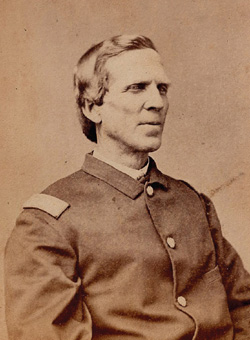
Please send all Checks and Money orders to :
Dave Taylor P.O. Box 87 Sylvania, OH 43560
419-842-1863
Click Here to E-mail Us!
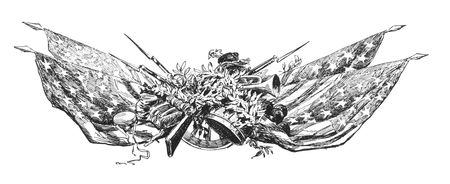
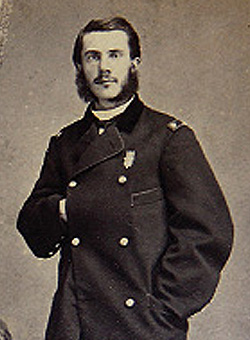
15 02
LAYAWAYS ARE WELCOME:
Need to split your order into multiple payments? No problem! A simple 20% earnest money deposit will hold your item for you.
You can then pay it off in easy installments that fit your budget.
Read Terms Here
~~~~~~~~~~

15-02-01 … Wonderful Inscribed Sword an Scabbard, Extra Fine Condition Colt Army Revolver, Bullet Mold and Bowie With Sheath Belonging to Lieut. Emery D. Bryant, 3rd Michigan Infantry and 102nd USCT. …
This is as nice a grouping of material from one officer as I’ve had in quite a while. Emery D. Bryant was 34 and a resident of Muskegon, MI, when he enlisted at Grand Rapids on 6/10/61 and was commissioned and mustered in as Captain of Co. H of the 3rd Michigan Infantry. That regiment served in the Army of the Potomac as part of Phil Kearney’s division of the Third Corps, fighting at Williamsburg and Fair Oaks on the Peninsula, where they lost some thirty men killed. They participated in the remaining battles of the campaign and were part of the forces sent to reinforce Pope during the Campaign of Second Bull Run. At the fierce battle fought at Groveton on 8/29/62, they lost another 28 men listed as killed outright in battle and many more wounded, some mortally. Bryant was discharged for disability on 10/11/62. Bryant rejoined the army back in Michigan, where the 1st Michigan Colored Infantry began recruiting in the Detroit area in 1863. The regiment was mustered into US service in early 1864 and received the designation 102nd US Colored Infantry in May, 1864. Bryant was commissioned a First Lieutenant in Co. H on 6/20/64 and served with them for the rest of the war. The regiment first joined the 9th Army Corps at Annapolis, then was assigned to the Department of the South, serving in Florida and South Carolina, seeing action at Baldwin, Fla., August 8, 1864; Honey Hill, S. C., November 30, 1864; Tullifinny, S. C., December 7, 1864; Deveaux Neck, S. C., December 9, 1864; Cuckwold’s Creek Bridge, February 8, 1865; Sumterville, S. C., April 8, 1865; Spring Hill, S. C., April 15, 1865; Swift Creek, S. C., April 17, 1865; Boykin’s, S. C., April 18, 1865; and Singleton’s Plantation, S. C., April 19, 1865. It lost during service five men killed in action and another seven mortally wounded. Bryant was promoted to Captain of Co. B on 5/6/65 and mustered out at Charleston, SC, on 9/30/65.
Bryant obviously meant business with his choice of weapons for field service. Much like General Francis Barlow, Bryant appropriated a government issue 1860 pattern light cavalry saber for field use rather than damage an expensive foot officer’s sword or break a leather scabbard. The saber is a highly desirable “double inscribed” weapon. His name is beautifully engraved in period script on the knucklebow of the sword itself: “Lieut. E. D. Bryant. 102nd U.S.C.T.” with the last two letters quite rubbed from wear. And to top it off… the scabbard is similarly engraved between the carrying rings on the steel scabbard in a single line. The saber is a Mansfield and Lamb product with clear marks and an 1864 date, excellent scabbard, nice full leather and wire on the grip and a good blade showing a dull silver overall with a light dusting of gray and brown but no pitting or nicks. The nicest part of the group is Bryant’s commercial Colt Army .44 cal. Revolver, serial number 65367, all matching, made about 1862, so possibly from his first service as well. About fine condition overall. Crisp barrel address, visible cylinder scene, and cylinder number, patent information, etc., sharp. There is a lot of original factory blue still present. Much on the back half of the barrel and some on the balance. Much blue in the rebated section on the cylinder. Some on the back strap. The case colors on the frame and rammer assembly are still evident as is some of the blue on the screw heads. The Colts Patent stamp is a bit light, but readable, as is the .44 Cal. marking on the upper triggerguard, which retains strong traces of silver. The grips are extra nice, tight fitting to the metal, no appreciable dings, and nice color to the back strap and butt. This is a stellar revolver, and with it comes Bryant’s Colt Patent marked bullet mold as well.
Lastly, we have Bryant’s double edge, spear point bowie knife with both its dress sheath and its outer leather belt sheath with slotted belt frog. The knife is German silver mounted with a stag handle and a nice bright blade that shows no grinding or sharpening by a misguided collector or family member. Very clear “H. Littlewood’s Celebrated Cutlery” marking on one side of the ricasso. This is a nice archive of material, as preserved by the family and a subsequent collector and not supplemented with the sweepings of local antique shops by some shyster. Bryant saw some interesting service as commander of Black soldiers during the Civil War. Researching the current wealth of information on the web will prove interesting and rewarding. Bryant lived only until 1897. Super display lot.
… $7,800.00 – SOLD
Click Here to E-mail Us!
Call us @ 419-842-1863

15-02-(2-4) … Gettysburg Battle Hero:
11th New Jersey Regimental Adjutant at Gettysburg, Regimental Commander at Gettysburg, Wounded at Gettysburg, Author of an Official Report of the Regiment at Gettysburg! … Three top-notch signed CDVs of John Schoonover, who was a lieutenant and the regimental adjutant at Gettysburg. Schoonover signed up early: 5/8/61 and joined the 1st New Jersey as a private, mustering into Co. D 5/22/61. He obviously had potential for he was promoted to Commissary Sergeant 3/24/62 and then discharged for promotion to 1st Lt. and Adjutant of the 11th New Jersey 8/2/62. The regiment brought 275 men onto the field at Gettysburg on July 2, 1863, and lost half of them trying to stem the fierce Confederate assaults along the Emmitsburg Road. Col. McAllister was wounded in the fighting, (see below for photo of him) the Major had already fallen, Captain Martin then took command, until he also was wounded, as was Captain Lloyd, who took over after Martin. When Lloyd went down Schoonover took command and led the regiment until later in the afternoon after being twice wounded. Schoonover rejoined the regiment the next day and resumed command at the request of the senior Captain present, and finished the battle having his horse shot out from under him. In August he supplemented McAllister’s report in the Official Records: A few minutes previous to the command “Fire!” spoken of in the accompanying report, Maj. Kearny, then standing near me on the left of the line, was struck by a Minie ball in the knee, and immediately carried to the rear… word was conveyed to me that both Capt.’s Martin and Logan were wounded and being carried to the rear. A moment later, and Capt. Ackerman fell dead by my side…. By this time Capt. Lloyd had also been wounded, and Capt. Dunning being absent in assisting the colonel to the rear, I assumed command of the regiment. The fire of the enemy was at this time perfectly terrific; men were falling on every side. It seemed as if but a few minutes could elapse before the entire line would be shot down, yet the galling fire was returned with equal vigor. Slowly and stubbornly the regiment fell back, keeping up a continual fire upon the line of the enemy, which was still advancing, until more than half of its number had been killed and wounded.” Schoonover received a well-deserved promotion to Lieutenant Colonel of the regiment 7/28/63 and served until mustered out 6/6/65, commanding the regiment for most of its service in 1864-65 while Col. McAllister commanded the brigade. In fact, most of the Official Reports were written by Schoonover as regimental commander, while the outfit served in the Second Army Corps after the dissolution of the Third in early 1864. Schoonover received a postwar brevet promotion to Colonel for his wartime service. I offer three very similar CDVs of Schoonover, all taken after his promotion to Lieutenant Colonel, all by the same photographer (Morse of Trenton, NJ), likely taken at the same sitting, and all signed by him ink. All have very slightly clipped corners for album insertion.
15-02-02 …
Vignetted mid-chest up view facing left in a field officer’s sack coat with shoulder straps and badge on his chest boldly signed in ink on the front: “Yours always Jno Schoonover Lt. Col. 11th NJV” Cancelled tax stamp reverse
… $495.00 – SOLD
15-02-03 …
Full standing, wearing the same double-breasted sack coat with shoulder straps and badge on breast, hand in lapel, signed in ink on reverse: “Yours truly Jno Schoonover Lt. Col. 11th NJV.”
… $595.00 – SOLD
15-02-04 …
Vignetted bust shot, ink signed below the image, “Yours truly Jno Schoonover Lt. Col. 11th N.J.Vols.” No tax stamp, but there likely was one at some point
… $495.00 – SOLD
Click Here to E-mail Us!
Call us @ 419-842-1863

15-02-05 … Quality Cased Civil War Compass:
Pocket size measuring roughly 2.25 inches in diameter. Perfect condition and perfect function. The compass is housed in a high quality leatherette hinged protective case made exactly the same as the 1860 tintype and ambrotype cases. Note the hook and eye closure. When moving troops through woods and swamps the compass is your most important tool. Anyone who has hunted in the woods knows that getting turned around after stumbling through an unfamiliar swamp for a half hour happens all the time. One of my favorite lines is from the movie The Mountain Men. It relates well to being lost in the wilderness… when asked if he’d ever been lost, Brian Keith refuses to admit it, and answers – smart alec tone: ” Hmm…. Been fearsome confused for a month or two, but I ain’t never been lost!” Guess he didn’t have one of these. Great personal item
… $265.00 – SOLD
Click Here to E-mail Us!
Call us @ 419-842-1863

15-02-06
…
13-12-46 … 19TH Century Military “Songster” …
Pocket size tract song book published in Boston. Not dated but appears to be 1860s to 1880s era. The title page references songs our “Grandmothers” sang, and the songs are mostly War of 1812 vintage. Some looseness in the binding – pages 129-144 missing. Nice illustrations inside. Very interesting and very appealing being very military in song and subject
… $25.00
– SOLD
Click Here to E-mail Us!
Call us @ 419-842-1863
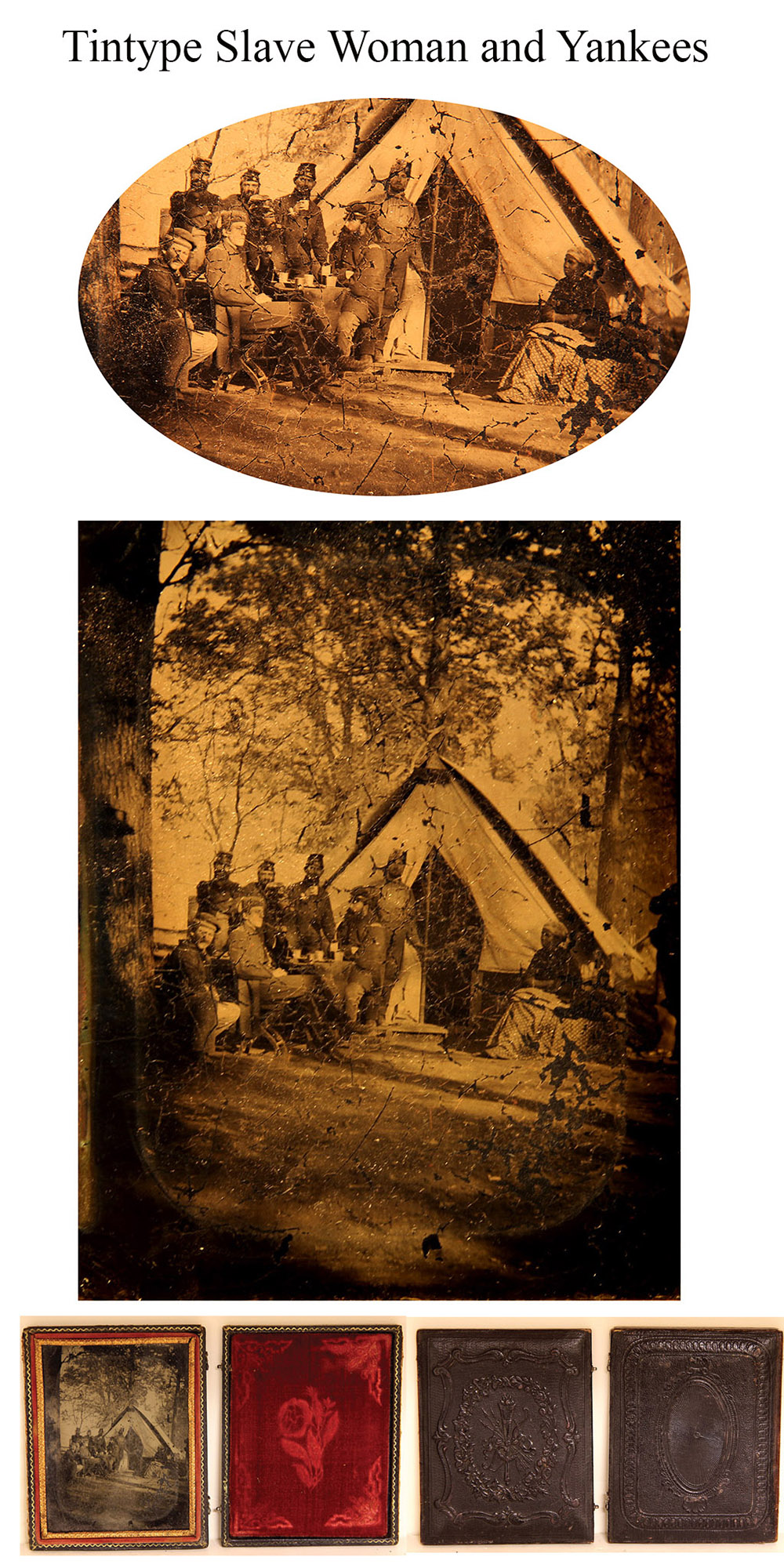
15-02-07 … Ex Slave Woman and Yankees in Camp …
This Quarter Plate outdoor tintype has some condition issues, scratches, alligatoring, and some small spots of emulsion loss, but what content! And the clarity is stellar. So clear you can see tiny cap numerals on one man! As well focused as any outdoor image I’ve owned. The blemishes are old and very stable. Eight officers (or seven officers and a soldier) are seated and standing around a table set with tin cups, a large bottle of whiskey, and tin plates. Seated opposite the group of soldiers, arms folded and looking on at the sassy group of white men is a black woman, obviously a recently freed slave hired by these officers as their camp servant. Two of the officers seated nearest the camera wear camp caps, or possibly Scottish tams. The others wear regulation forage caps. One of the standing figures raises a cup to his mouth. His cap shows two numerals, but not quite large enough to read them. The rest are posed with arms folded or in their laps. Two of the seated officers are clearly having a “stare down”. Where the others are in frock coats, the standing figure at the tent entrance is in shirt sleeves and might be an enlisted man assigned to act as their camp servant or “waiter.” Along the right edge of the photo, a bystander has been partially caught looking on.
Trees are evident in the left foreground and background, and the tent has a fly over it and wood flooring, so we are in a somewhat fixed camp as the presence of the cook would lead us to expect. Perhaps the Tam style caps indicate a Scottish regiment… or maybe they are simply camp caps. The ex-slave woman’s pose, arms folded like some of the officers, seems to convey she has done her job, is satisfied with the result, and awaits another assignment. She also seems to show some curiosity in her gaze at these white soldiers in her native South. I am certain she preferred serving Union officers to slave owners… but her facial expression does not show complete comfort with her position in the group. Her crossed arms and those of one seated officer who even has his hands tucked under his arms may mean that it was simply chilly weather on that photo day 150 years ago, as opposed to the crossed arms being an indication of body language. Under high power magnification this image is MAGICAL. A great photograph, of a group quite literally frozen in time. A million dollar image priced most affordably due to some age issues. Very attractive and visually exciting. Housed in a full case with glass and frame, and signs it once had an oval mat
… $895.00 – SOLD
Click Here to E-mail Us!
Call us @ 419-842-1863
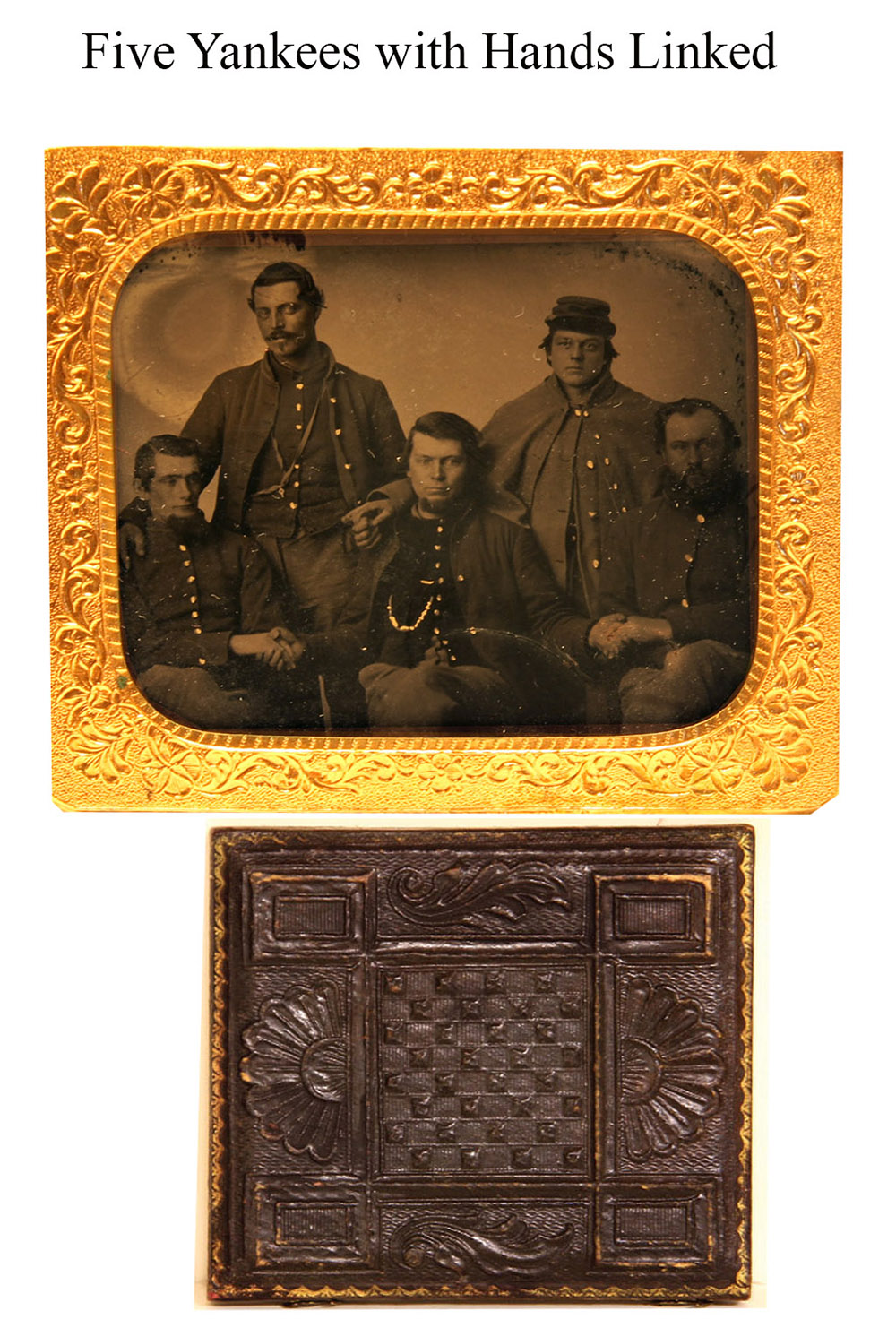
15-02-08 … Sixth Plate Tintype of Five Yankees Dressed for Cold Weather …
Most civil war photography incorporates a single subject. Images of multiple subjects are scarce. Images showing five soldiers in one sitting are down right rare. Th is one is in fine condition with strong contrast and clarity … housed in a 1/2 leatherette case.
… $295.00 – SOLD
Click Here to E-mail Us!
Call us @ 419-842-1863
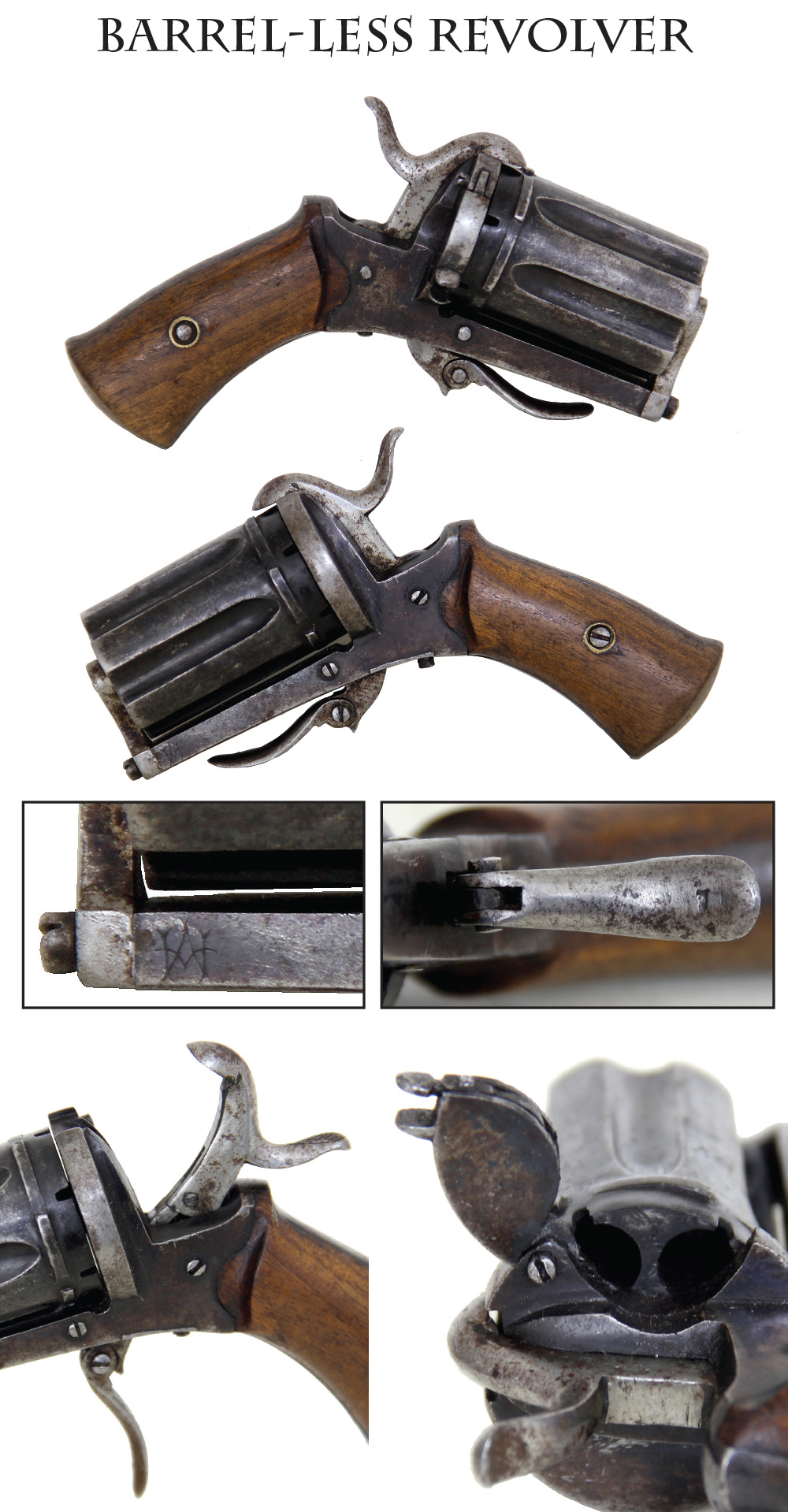
15-02-09 … Pinfire Knuckleduster …
These little revolvers were meant for trouble. Made without a barrel and with a folding trigger, they were meant to slip into a pocket easily, and come out quickly with little notice. Likely produced 1860s to 1870s. Small in size … about 5 inches overall. Six shot, 7mm pinfire, and unmarked except for a small monogram on the forward lower edge of the frame. Screw fastened wood grips. Retains some blue and case color, perhaps 20%. Trigger, hammer, recoil shield and front bracket are silver gray with some brown. Loading gate in place, which is often missing from pinfires. A neat little gambler’s gun or self defense weapon for dangerous streets and establishments of low character. The folding trigger and compact design also meant that as a last resort in a clenched fist it could do some damage as well. Mechanically fine
… $585.00 – SOLD
Click Here to E-mail Us!
Call us @ 419-842-1863
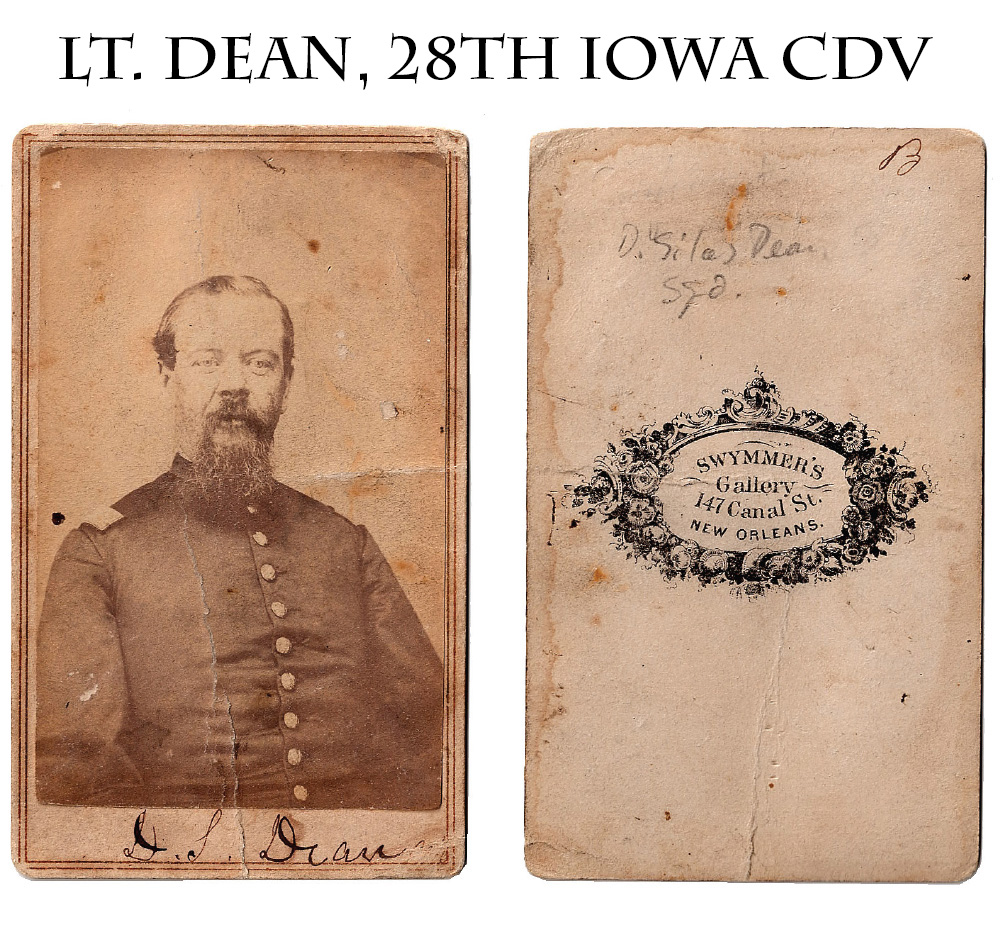
15-02-10 … Lieutenant Daniel S. Dean 28th Iowa, Severely Wounded at Winchester …
CDV Photo Bearded Yankee officer, waist-up seated view in his frock coat with shoulder straps, vertical crease on card running along left side of figure’s chest. Period ink id at bottom “D.S. Dean” and pencil id on reverse “D. Silas Dean,” Swymmer’s, New Orleans backmark. Our man is Daniel S. Dean of the 28th Iowa. He resided in Montezuma, Iowa, and was 43 when he enlisted on 8/13/62 as a 1st Lieutenant and was commissioned into Co. C of the 28th Iowa on 10/10/62. He was severely wounded at Winchester, VA, 9/19/64, and resigned 11/2/64. He received brevet promotion to Captain of US Volunteers dated 3/13/65.
The 28th Iowa served in the 13th Corps, Department of the Tennessee and the Army and Department of the Gulf. In August, 1864, they joined the 19th Army Corps and went north as part of the Army of the Shenandoah. They first saw service in Arkansas and Louisiana, but got their first real taste of battle in Mississippi at Port Gibson, Champion’s Hill (where they lost more than 20 killed), Vicksburg, and Jackson. In April, 1864, at Sabine Cross Roads, LA, they lost 80 in killed and wounded according to their summary of service, and having joined the Army of the Shenandoah, at Winchester, where Dean was hit, they lost 10 killed, 59 wounded and 24 missing according to CW data, or 90 in killed and wounded according to their history, and saw action at Fisher’s Hill and Cedar Creek as well. The regiment was in New Orleans around March 1, 1864, which is the likely occasion of Dean’s photograph. A rural western officer who saw some action
… $85.00 – SOLD
Click Here to E-mail Us!
Call us @ 419-842-1863

15-02-11 … Gettysburg Hero Robert McAllister: New Jersey Regimental Commander Wounded in Action at Gettysburg, Brevet Brigadier and Brevet Major General …
Very rare, period waist up seated view of this gallant officer in a plain officer’s sack coat with shoulder straps. Wenderoth and Taylor, Philadelphia, backmark. Period ink id reverse: “R. McAllister” and period pencil addition: “Maj Gen Vol’s / Col. 11th NJ” McAllister (1813-1891) enlisted at age 47 on 5/21/61 as Lt. Col. of the 1st NJ, with whom he served until discharged for promotion to Colonel of the 11th New Jersey on 6/30/62 and was commissioned 8/18/62, serving as their commander until the end of the war, much of that time actually commanding the brigade. He was an unassuming but very competent officer, earning a brevet promotion to Brigadier General in October, 1864, for his actions at the Boydton Plank Road where he led the brigade, now assigned to Mott’s division and part of the Second Corps. His wartime record earned him a March of 1865 brevet to Major General as well. At Gettysburg, as part of the Third Corps, the regiment fought under his command near the Klingle farmhouse on the Emmitsburg Road on July 2. In the ferocious fighting the regiment lost more than half its men killed and wounded, including McAllister and three more officers who successively took command of the regiment (one of whom was Adjutant John Schoonover, whose photographs I also offer on this list.) Both Gettysburg and New Jersey material is scarce. This is sort of two for one. It is an additional bonus that McAllister’s letters have been published, well reviewed by Civil War historians, and are readily available
… $595.00 – SOLD
Click Here to E-mail Us!
Call us @ 419-842-1863
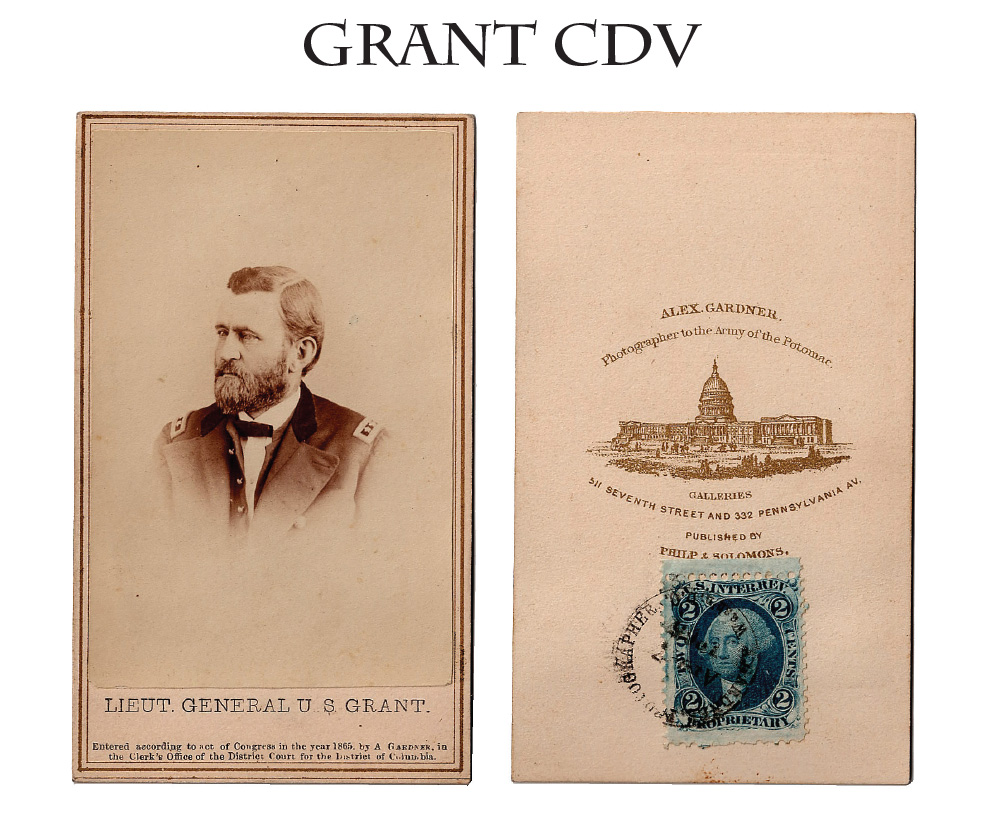
15-02-12 … CDV of Grant From Life by Gardner …
Here is a rare from life view of General Grant by Alexander Gardner with a printed caption at bottom along with Gardner’s 1865 copyright. On reverse is Gardner’s backmark and a two cent blue revenue stamp which carries Gardner’s studio circular cancellation. This crisp vignetted mid-chest up view shows the commander of the Federal armies in a typically informal pose with his frock coat and vest both at least partially unbuttoned, but displaying shoulder straps each with two of his three stars as Lieutenant General visible to the observer. A very handsome and incredibly scarce view of Grant, from life, not a period copy shot, and all this by famed photographer Alexander Gardner
… $695.00 – SOLD
Click Here to E-mail Us!
Call us @ 419-842-1863
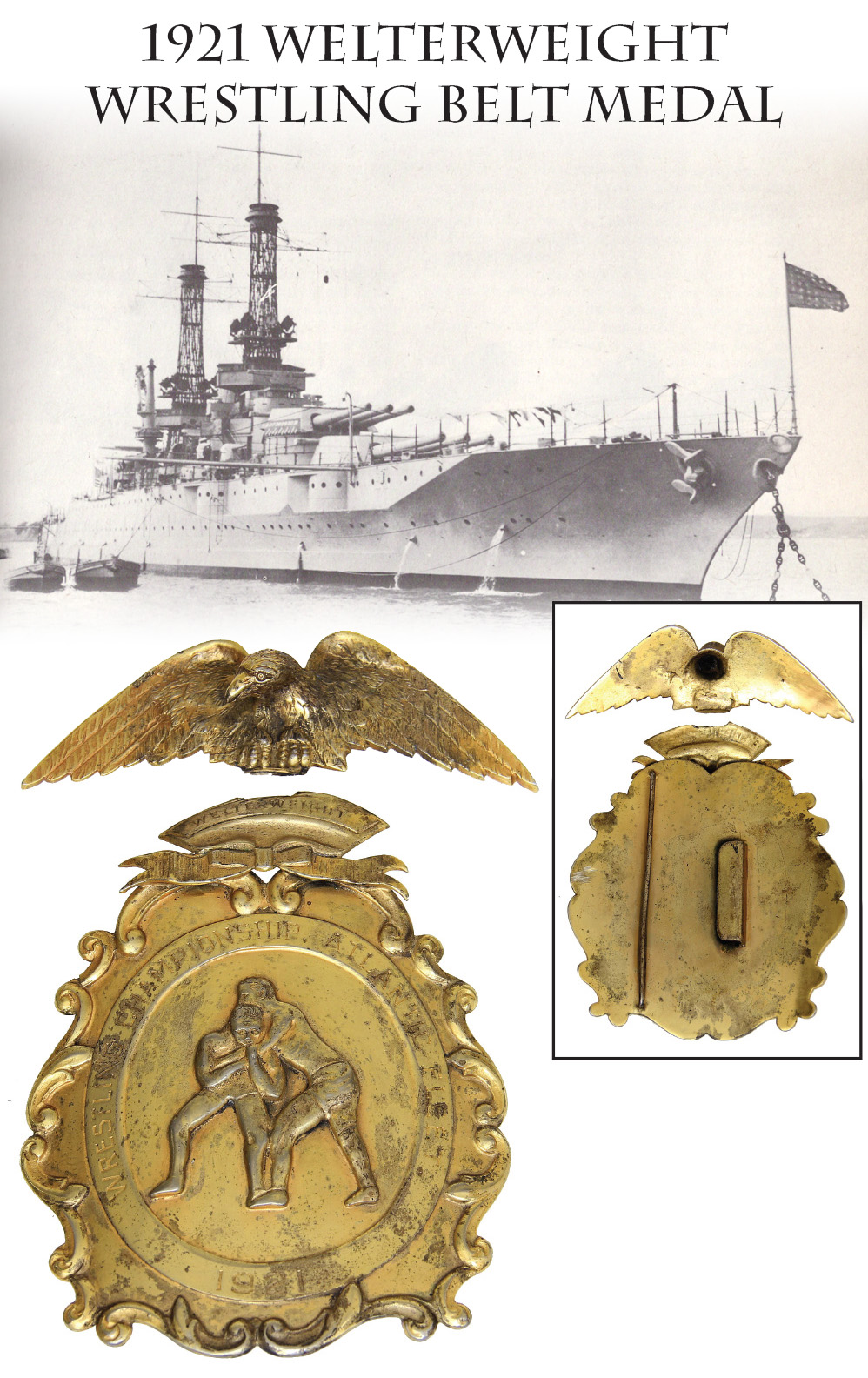
15-02-13 … 1921 Wrestling Belt Medal …
Atlantic Fleet Welterweight Wrestling Championship Belt Buckle for 1921 …
A local fellow brought this into our shop. He called on the phone. I made him an offer which he accepted. He put the buckle in his back pocket and jumped in his truck to deliver it. Well the doofus broke the eagle off the top when he sat on it!!! A jeweler can repair this using gold solder. I will leave that for you. It is an elaborate brass belt buckle with two standing wrestlers in the central cartouche with “WRESTLING CHAMPIONSHIP ATLANTIC FLEET” above and “1921” below. Just over this is a knotted ribband and panel reading “WELTERWEIGHT.” This was surmounted by a beautiful spread-winged eagle (now detached,) … This likely belonged to Jack Bloomfield, who is recorded as the welterweight champion wrestler of the navy in 1921, “and all round entertainer of the Idaho.” I asked helper Tom about it, while he vaguely remembers seeing most of the 1921 matches, he was unsure whether this was the same Jack Bloomfield who got professional cage wrestling started in 1937. Some spotting to the brass and age patina,… would look great mounted in a wall frame. A neat prewar USN and sporting relic as well
… $225.00 – SOLD
Click Here to E-mail Us!
Call us @ 419-842-1863

15-02-14 … Regulation Civil War Eagle Drum by Rogers, Flushing, NY …
Regulation eagle drums are about the most visually attractive of all Civil War material and have always been sought after not just by the military collector but by general line antique and Americana collectors. The pricing has almost always been driven by the demands of the folk art market. Here is a very solid example of one made by Alexander Rogers of Flushing, NY, who had a number of early war contracts with the government: Bazelon lists seven between August, 1862, and September, 1863, and another three at a date not stated. This one is full height with very strong paint, just some abrasion below the eagle’s talons, and the bottom and top edges where the flesh hoops and rims overlapped the body. The latter does not affect the paint much. On the bottom it is well below the painted panel and at the top it just slight touches the tip of the highest sunrays over the eagle and clouds.
It is a plus, also, that it definitely saw some use. The back shows some wear and abrasion from actually being carried and the upper rim show wear between the ropes from the drum sticks hitting the rim. The upper rim shows some cracking and wood loss at the overlap and could be repaired but is stable. In any case, both rims preserve most of their original red paint. The top head is present, though loose- and a poor fit. The head was off the drum for many years and the flesh hoop has become warped. The bottom head is gone as is the bottom flesh hoop. The open bottom does not show on display and it lets you see the wonderful large maker’s label close up. Three leather tighteners are the original ones to the drum. The others are rawhide ties. The rope is the universal replacement for a frayed original: a length of old clothesline. This could be easily replaced by a correctly made copy. Three of the brass tacks are missing, but I would leave them as is since it adds to the real field-used flavor of the piece. I love painted drums for the history and the eye-appeal. The center piece of any Civil War or Americana collection. To put the value in perspective … Francis Bannerman & Co. listed an eagle drum for sale in their catalog in 1909. Price 115 years ago was $50. An ungodly sum. Over a month’s pay. In the same catalog you could buy CW revolvers for $5 and rifles and muskets for less than $10. My guess is that Bannerman’s did not actually care to sell the drum because it was such a nice display item. Most current drum owners feel the same way. Suffice it to say these eagle drums have never been cheap
… $4,650.00
Click Here to E-mail Us!
Call us @ 419-842-1863
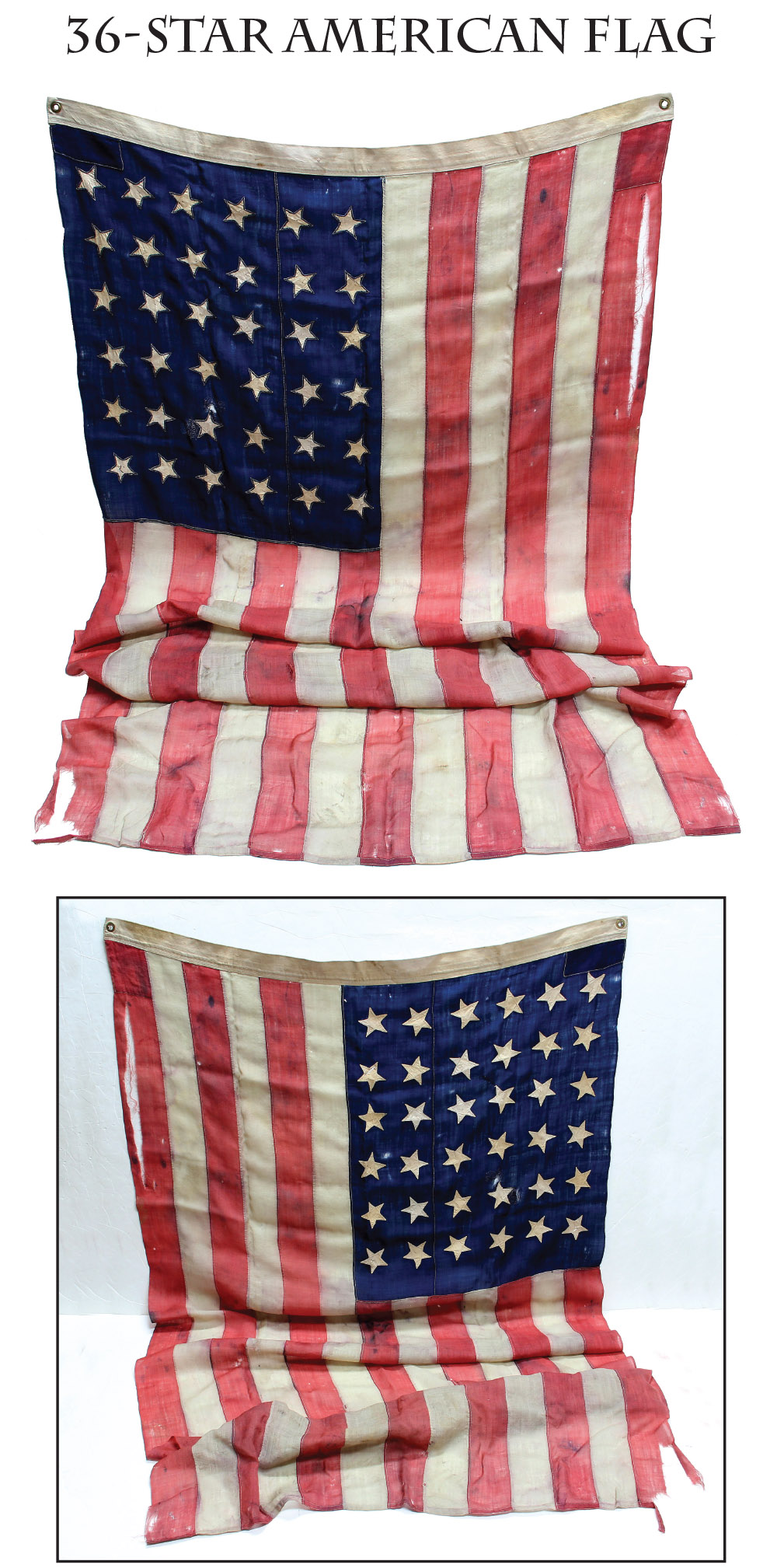
15-02-15 … 36-Star U.S. Flag Recognizing Nevada’s Statehood in October, 1864 …
After Congress passed an enabling act in March, 1864, and Nevada voted for statehood, Lincoln formally announced its statehood on October 31, 1864. Of course, flag manufacturers were certainly gearing up before that. Even though the federal government could not officially adopt 36 stars until the next July 4th, no one else would be waiting around for nine months if they had orders for flags. ( By tradition a star for a new state is added to the American flag on the following 4th of July. ) There are plenty of wartime military flags surviving which were carried with the 36 star count before the war ended six months later. Ours is a nice bunting example with machine sewn stripes and hand sewn stars. It has strong colors, measures 48 by 108 inches. The separately applied (hand sewn) stars are arranged six-by-six on deep blue canton. Like the canton, the red and white stripes are generally solid, with just a little bit of fraying at the fly end and some tears along the bottom stripe. There is one old repair: a small rectangular patch in the upper hoist edge of the canton. Flags have always been popular and general interest in the antiques world has sent some prices through the roof. When framing these longer flags it is perfectly fine to fold under a length from fly-end so that it can be displayed in a more civilized size frame. Or perfect to display tastefully folded in a glass case. This one is reasonably priced at
… $650.00 – SOLD
Click Here to E-mail Us!
Call us @ 419-842-1863
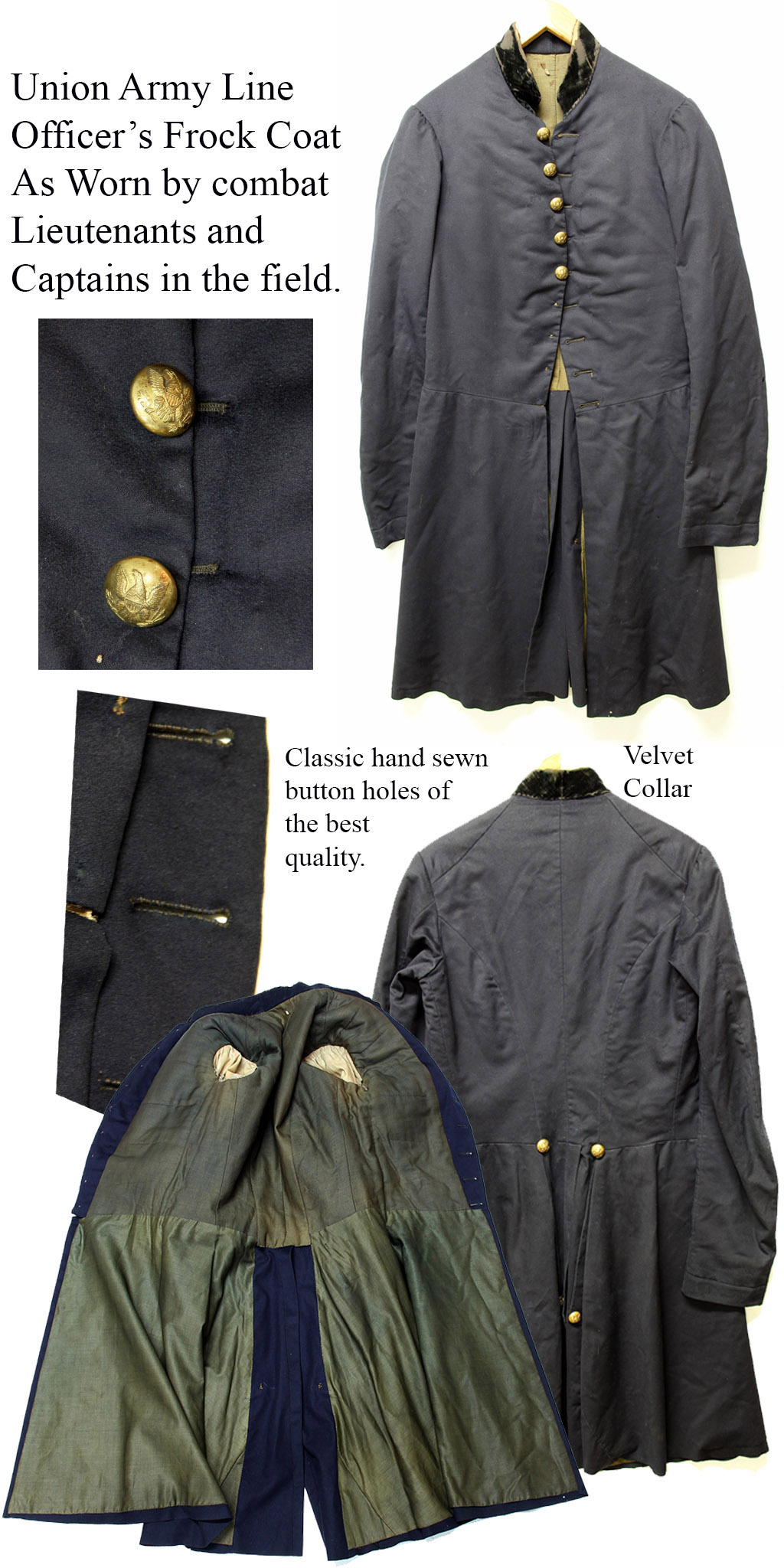
15-02-16 … Union Army Line Officer’s Frock Coat …
Regulation Union army officer’s frock coat as worn by Lieutenants and Captains of all branches of service. A very nice condition example of the typical fighting officer’s coat as worn both on parade and in the field. The single breasted nine-button officer’s coat marked its wearer as a company grade officer, with his exact rank made clear by his shoulder straps, or on full dress occasions by his epaulets. Regulation dark blue wool satinette with five of nine buttons on the breast, and four on the tails. Three smaller buttons, now missing, were on each cuff. The coat follows the standard practice of being unhemmed at the bottom and having a silk lining that has oxidized to the typical green color we expect. The chest shows the typical padding, with an internal pocket on the left breast, and pockets in the tails as well. Plain white sleeve linings are in place and all seams are solid and tight. The original owner allowed himself one special touch: he had the standing collar faced with black velvet, which now shows some wear to the nap. The buttons on the coat are general service buttons, more appropriate to an enlisted man than an officer. Family members likely helped themselves to the fancier Eagle-I, Eagle-C or Eagle-A buttons that were originally on it. Any of those would be suitable replacements as the pattern was worn by all branches of service. This would be the centerpiece of any officer display. Solid and very displayable
… $2,850.00 – SOLD
Click Here to E-mail Us!
Call us @ 419-842-1863

15-02-17 … Superb high Quality Wartime Surgeon’s Amputation Kit by Goulding …
Very showy, high quality, cased set for some very bloody work: a surgeon’s cased amputation kit. Red velvet lined, brass bound Mahogany (?) case with inset German silver plaque reading “F.G. Fay, M.D” All the instruments are signed by famed maker Goulding except the tourniquet which was made by Hernstein (also a wartime maker). The saw has a high art brass spine which was an element unique to Goulding. He made some where the brass spine terminated in an eagle’s head! Those are spectacular. A pair of tweezers is held inside the lid with the saw. In the lower section a scalpel, tenaculum and four amputation knives, all with checkered ebony handles, fill out the box. It is lacking only the rongeur (knawing forceps).
The box and tools are wartime manufacture. Owner Dr. Fay was not a surgeon in the army and was likely the second owner of the kit. My gut feeling is that Dr. F.G. Fay’s father was an army surgeon and passed the kit to his son who also chose the medical profession. I say this because the kit is pre 1865 but the engraved plaque on the lid is engraved in a later style of lettering. This will be an interesting research project for you. This is a very handsome and high quality surgeon’s set from the 1850 to 1860 period and representative of what a medical man would take into military service with him to do the grisly work of amputating limbs
… $4,500.00 – SOLD
Click Here to E-mail Us!
Call us @ 419-842-1863
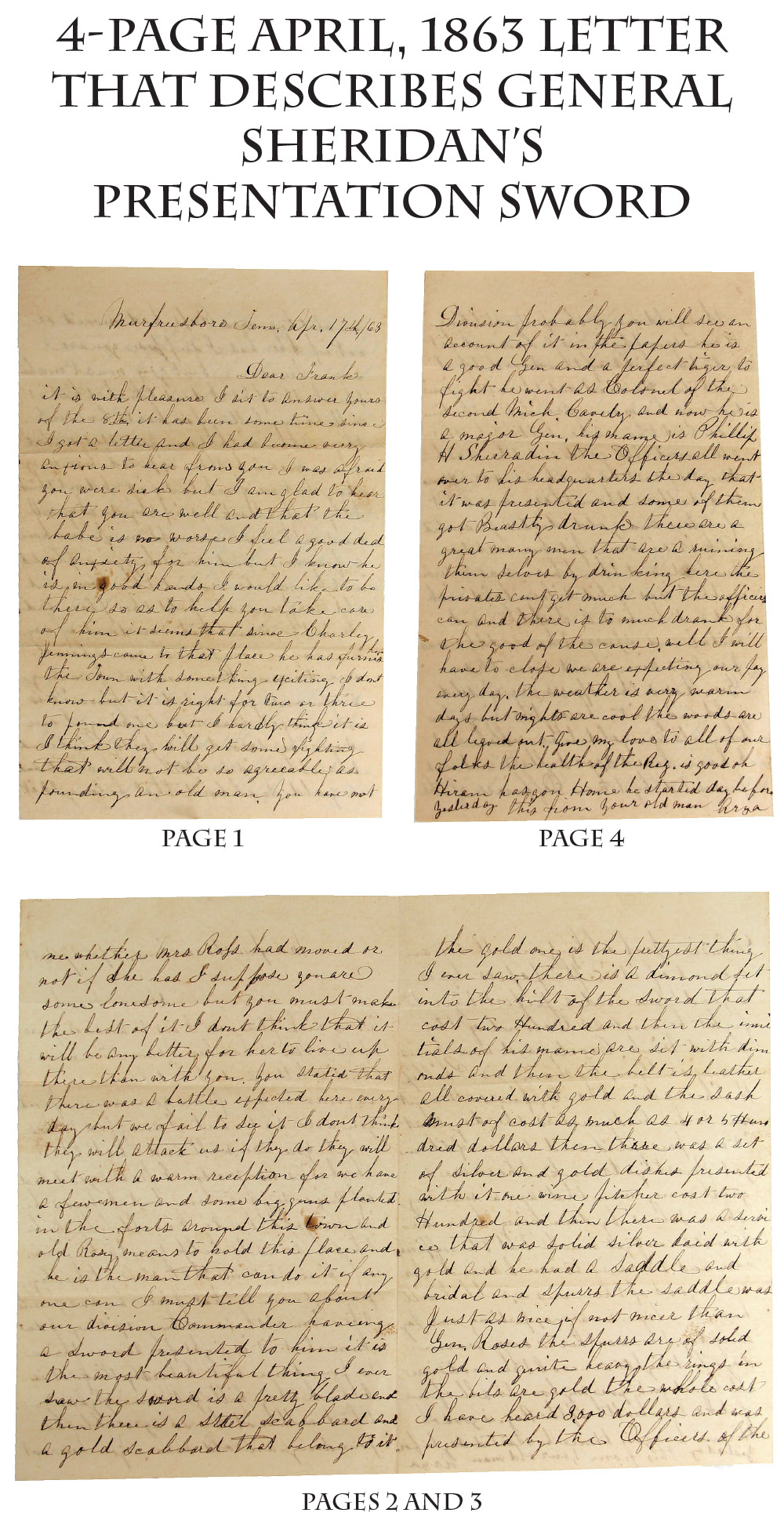
15-02-18 … Letter With Wonderful Content Regarding A Sword Presentation To general Sheridan …
“He is a good Gen. and a perfect tiger to fight he went as Colonel of the second Mich cavalry and now he is a major Gen. his name is Phillip H. Sherradin…” so writes a soldier in Sheridan’s division in a letter from Murfreesboro Tenn. dated Apr. 17th/63. General Rosecrans, “Old Rosey,” comes in for favorable mention, but the writer is most impressed with the beauty and cost of a presentation sword given to Sheridan by officers of the division. “The sword is the most beautiful thing I ever saw…. a steel scabbard and a gold scabbard… a diamond set into the hilt of the sword that cost two hundred and then the initials of his name are set with diamonds and then the belt is leather all covered with gold…” and he goes on to tell about a set of silver and gold dishes with it and a saddle, bridle and gold spurs that were even nicer than those Rosecrans had. He ends by noting the officers all went over to Sheridan’s headquarters afterwards, “and some of them got Beastly drunk.” The writer signs the letter with the phrase “this from your old man,” and seems to be written to an adult son. There is a reference at the opening to a baby at home being sick, either the writer’s grandson or another, younger, child. This is a wonderfully descriptive letter that well conveys the respect in which Sheridan was held by his officers and men and the reputation he had as a combat general. It is little wonder that Grant regarded him with Sherman as his two most reliable commanders, and generals not afraid of a fight. Wonderful letter
… $450.00
Click Here to E-mail Us!
Call us @ 419-842-1863

15-02-19 … A Civil War Marine’s Medal !!! Massachusetts Minutemen Medal Given to the First Responders of the State: Edward Jennings, Third Battalion Rifles and U.S. Marines …
Bronze medal presented by the state to men who responded immediately to the bombardment of Fort Sumter and Lincoln’s first call for troops. The top is a pin reading “Massachusetts Minute Men 1861” from which hangs a round medal with the state seal on the obverse, and on the reverse: “The Commonwealth of Massachusetts to the members of the Massachusetts volunteer militia who were mustered into the United States service in response to President Lincoln’s first call for troops April 15, 1861.” The edge is stamped with the soldier’s name: “Edward Jennings Prvt. C. 3d Batn. RFN” Jennings was from Grafton, MA, and 20 years old when he enlisted as a private in Co. C of the 3rd Battalion of Riflemen, Mass. Volunteer Militia. The 3rd Rifles was a battalion of three companies headquartered in Worcester. Special Order Number 31, dated April 18 ordered them to muster and they set out from Worcester for New York and sailed from there for Annapolis, MD, where they were posted from April 24 to May 2, when they were sent to Baltimore and posted at Fort McHenry doing guard and garrison duty and working on the fort. It was not until May 19 that they were actually mustered into federal service for three months service, so his dates of service often read from that date, though they had been on duty a month earlier. At the end of July they entrained for Boston and were mustered out on August 3. Jennings stayed at home less than a month before signing up in the U.S. Marine Corps on Aug. 30, 1861, at Boston for four years and served his full enlistment, serving on the USS Great Western and at Mound City Station. He was discharged in Washington on Sept. 2, 1865. Finding items owned by a real US Marine during the Civil War is unheard of rare. The medals themselves are relatively common. They sell for a couple hundred dollars give or take and I have several in inventory. But a USMC solder’s medal is a horse of a different color. This is the first I have ever encountered related to the USMC
… $495.00 – SOLD
Click Here to E-mail Us!
Call us @ 419-842-1863
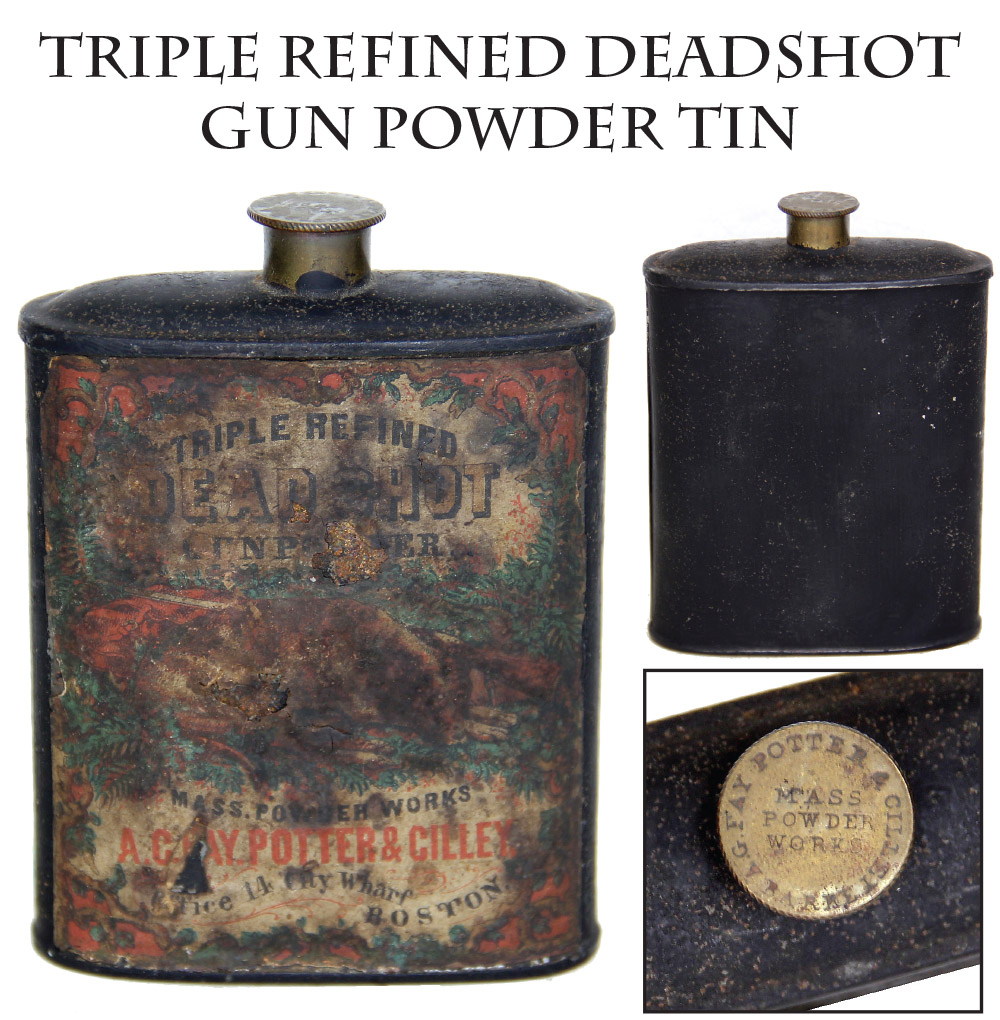
15-02-20 … Triple Refined Deadshot Gunpowder Tin CW Era …
A.G. Fay, Potter and Cilley powder tin. They ran the Massachusetts Powder Works in Barre, MA, with an office in Boston. A blue enameled tin with a full color paper label reading “Triple Refined Deadshot Gunpowder” with a hunting dog resting underneath beside his master’s rifle or shotgun and the business name and address below. The brass cap is still in place bearing their company name as well. The label has seen better days, with a couple of rust spots coming up through it and dark areas, but it still has some eye appeal and would look good in a period sporting collection. The company first incorporated in 1863
… $69.00 – SOLD
Click Here to E-mail Us!
Call us @ 419-842-1863

15-02-21 … Teat Fire Revolver …
Fine Condition Moore Teat-Fire Revolver and Officer’s Sash … These did not come together, but they look good together in the photograph! The Moore is in super condition, rating about Fine with excellent grips, strong remnants of silver on the deeply engraved brass frame and very good blue on the cylinder that thins out somewhat along the barrel, the colors in general being stronger on the right than the left from lying on its side. Very crisp “Moore’s Pat. Firearms Co. Brooklyn N.Y.” barrel markings and D. Williamson’s Patent January 5, 1864,” with a serial number 17279 under the barrel. There are a number of variations in these. These six shot revolvers fired a special .32 cartridge (hence the “teat-fire”) and the system enabled the company to avoid infringing on the Rollin White patents for bored through cylinders, etc. The gun was popular enough- about 30,000 of them were made from about 1864 to 1870 that Colt saw them as a viable threat and bought out the operation in 1870. The engraving on the frames is wonderful and this is a very nice example with much finish
… $695.00
15-02-22 … The Civil War Officer’s Sash
is the regulation pattern for all officers of every rank in the different army branches all the way up to General (the only exception being the medical branch.) This is in unusually good condition with no tears or runs and just minimal wear on the high points of the tassels where they exit the knots at each end. Even better, this one still retains vivid crimson color. You will be very hard pressed to find another one as nice
… $650.00 – SOLD
Click Here to E-mail Us!
Call us @ 419-842-1863
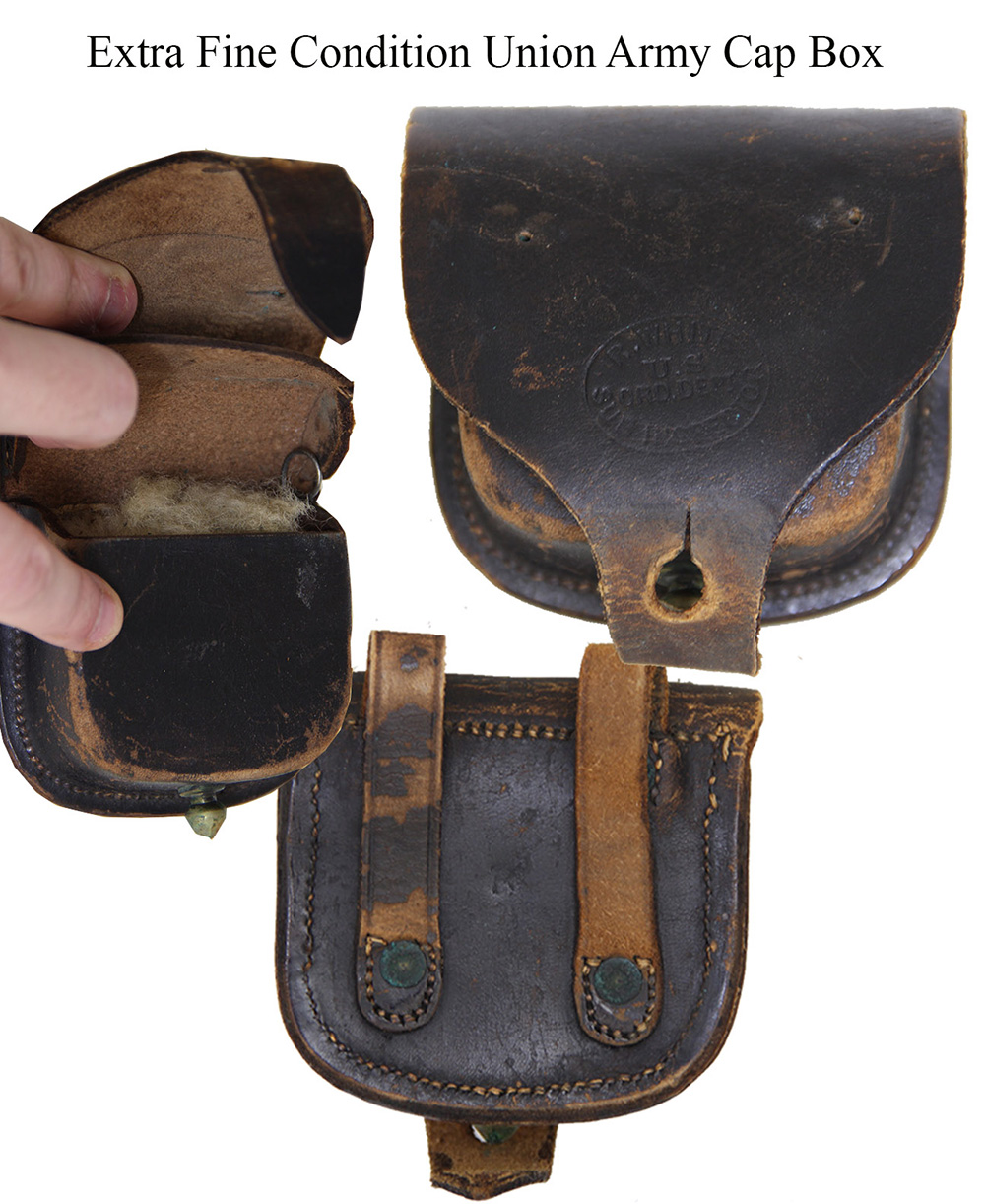
15-02-23 … Extra Fine Condition Union Army Cap Box With Fleece and Pick …
Very crisp WHITE / ORD DEPT/ SUB INSPECTOR markings really stand out on the outer flap of this cap pouch and a small “B” stamp on the reverse. It did see some use- there is a little rubbing along the edges and latchtab hole and the belt loops lost some of their finish from flexing, but this is a nice one! The side ears are in place and tight, the finish is smooth and not alligatored or crackling and, best of all, it still has the sewn band of fleece inside that was intended to keep the percussion caps from bouncing out while the soldier moved, and it also still has the simple wire pick used to clear fouling from the musket’s vent. Both these things are usually lost to moths or carelessness over the years. Two small pin holes on the outer flap indicate some insignia was once mounted there, but there is not much sign of what it was. I haven’t hit this with any polish or dressing. It’s untouched and in great condition as it is. In the age of percussion arms, every soldier carried one of these on his belt and it is a key Civil War accoutrement with lots of variations for the collector. Much better than most we find
… $235.00 – SOLD
Click Here to E-mail Us!
Call us @ 419-842-1863
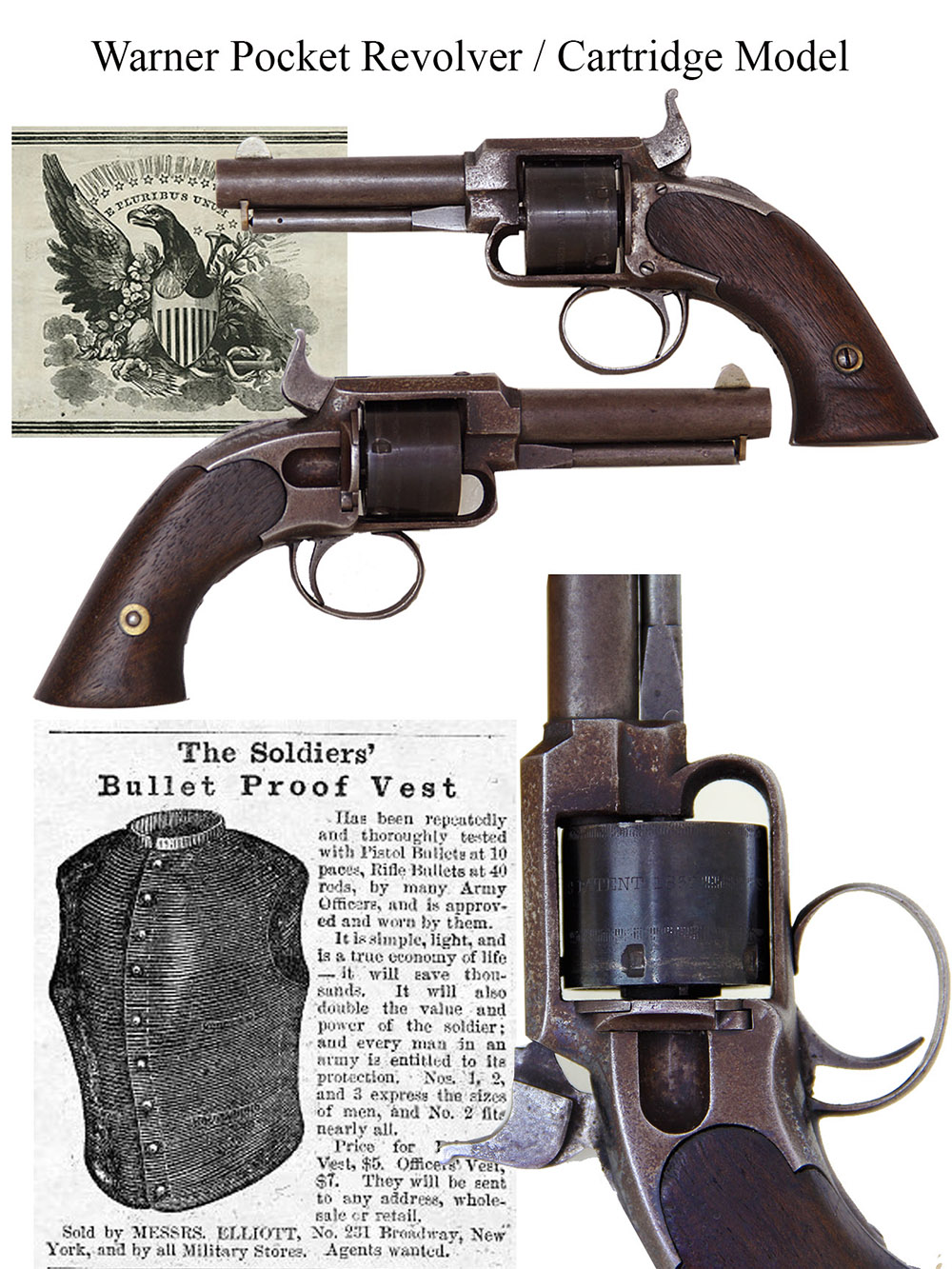
15-02-24 … Warner Rimfire Pocket Revolver …
These handy little five-shot .30 caliber rimfire revolvers were made in the late 1860s with a total manufactured of only about a thousand according to Flayderman. It will fit in the palm of your hand. Ours has requisite three-inch round barrel with tall semi-circular front sight in place, as is the loading gate and cylinder pin that acted as an ejector. The grips are excellent with no damage and tight fit to the metal. The original blued finish has faded to a plum brown with some gray speckling showing through toward the rear of the frame and hammer. The cylinder preserves a ton of color and sharp “Warner’s Patent 1857” markings. VG++ condition. Mechanically fine. A good early western traveler’s weapon and not out of place at a poker game or faro table either
… $695.00 – SOLD
Click Here to E-mail Us!
Call us @ 419-842-1863

15-02-25 … Inscribed Soldier’s Christian Commission Hymn Book Possibly Owned by General Winfield Scott Hancock’s Brother John, Who Served on the General’s Staff …
The U.S. Christian Commission handed out thousands of these small hymn books to soldiers during the war and they often show up in veterans’ effects. This one is in very good condition, the book itself solid with pages in place, and especially presentable with the printed pasteboard covers still intact front and back. These preserve the information that the book was distributed by the Central Office, 13 Bank St., Philadelphia. Inside the front cover in period pencil is the inscription, “A.Q.M. Hancock” and opposite this on the flyleaf in bolder ink is, “Capt. / J. Hancock” complete with the little flourish underneath in imitation of his Colonial namesake. I find only four officers with that name and two did not serve as Captains. The remaining two are from Maryland and Pennsylvania. The Marylander served in the First Virginia (US) Cavalry and the First Maryland. The Pennsylvania association of the hymn book, however, seems to point more to Lt. John Hancock of the 49th Pennsylvania, whose brother Winfield Scott Hancock commanded the brigade and pulled John from the regiment to staff duty in February, 1862. John enlisted 11/29/61 and was discharged for promotion on 2/3/62 and is listed as Acting Assistant Adjutant General on Hancock’s staff, commissioned Captain 2/3/62; Major 3/31/63; Lt. Col. by brevet 12/2/64 and Colonel by brevet 3/13/65. His name shows up on official reports as a member of Hancock’s division staff as well, and seems to have later served on Gibbon’s division staff in the same capacity. He was mustered out 9/1/66 and lived in Washington, DC, after the war, and is buried at Arlington. I don’t find John listed as Asst. Quartermaster in the 49th PV, but the fellow who is listed did not take the post until March, 1862, and John may have filled that regimental staff post before that, until he departed for further staff duty with his brother. If we have the right man, and I believe we do, he certainly saw a lot of service, and there will be some interesting research to be done in any case. Most historical
… $295.00 – SOLD
Click Here to E-mail Us!
Call us @ 419-842-1863
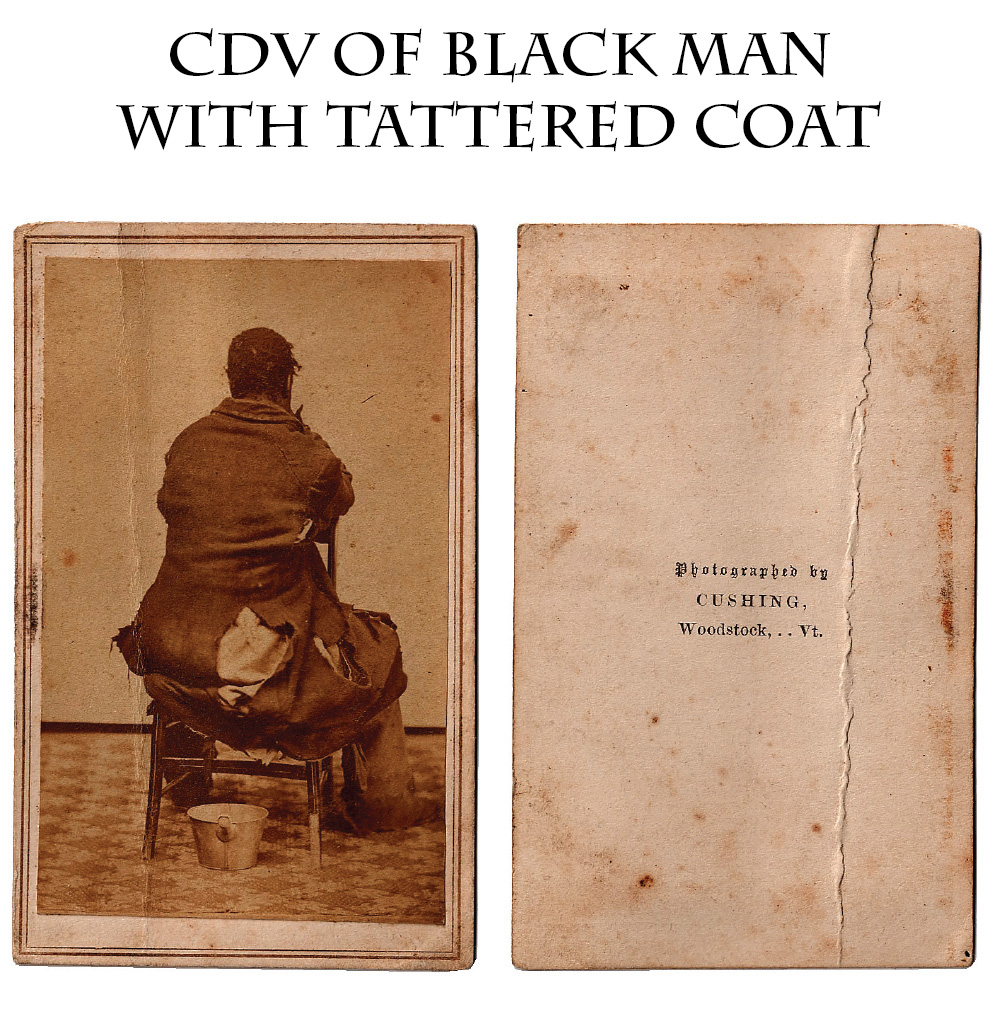
15-02-26 … Unusually Posed CDV of a Black Man Displaying His Tattered Coat …
Very unusual photograph of a black man seated with his back to the camera displaying a torn and ragged coat. If you want to know what hard times looked like, this is it. Photographed by Cushing, Woodstock, Vermont. There is little to go on – the man has turned his face from the camera, not anxious to be identified, but willing to show his state. A small tin pail sits on the floor behind him. Perhaps like tin cup it could be used for begging. More likely it is meant to be seen as his only possession. A vertical crease runs down the left side about a quarter of the way across that just strikes the left side of the figure, but does not really affect it much to my eye. It’s a strong image. A weird piece of CW photography
… $295.00 – SOLD
Click Here to E-mail Us!
Call us @ 419-842-1863
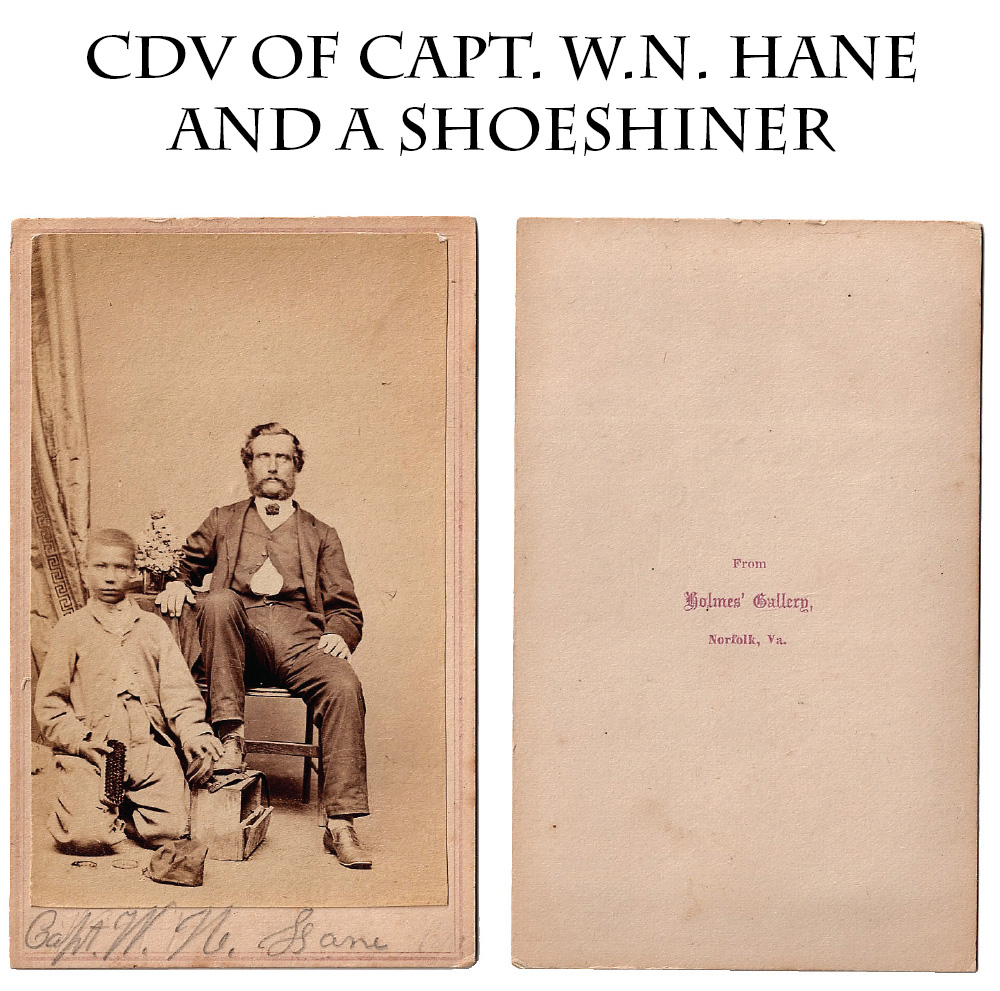
15-02-27 … Occupational Shoe Shine Boy With Social Commentary – Captain Lane gets A Shoeshine …
This Norfolk, Virginia, backmarked CDV has a lot going for it. A young black boy is posed with his shoeshine kit, brushes in hand kneeling next to an imperious looking white fellow. The reading white man has put one foot on the boy’s shoe-shine box to oblige. There is nothing playful in either face. Nothing that indicates they think there is anything unusual in posing together that way in a photographer’s studio. We can’t know what they were thinking, but the image conveys the message, “this is not a joke.” There is a nice period pencil identification at the bottom front that I read as “Capt. W. N. Lane.” My first thought is that we are looking at a former Confederate officer, but the Norfolk backmark suggests we might be looking at a ship’s Captain. (Even my so-called research-wizard could not give a definite answer and I am demoting him to magician.) I would date the card to 1866 or 1867 and think it evokes a lot about reconstruction and relations between the races, whatever the dynamic of the two people shown. A very telling image
… $150.00 – SOLD
Click Here to E-mail Us!
Call us @ 419-842-1863
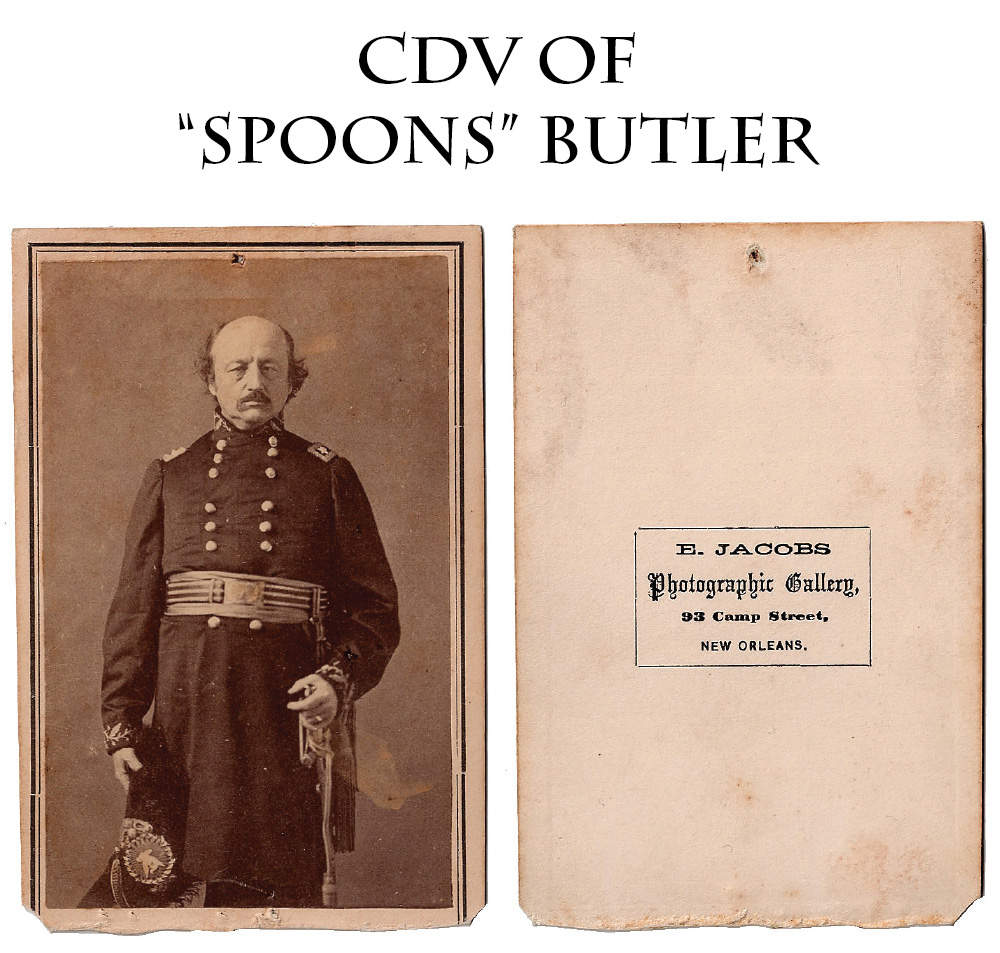
15-02-28 … “SPOONS” Butler Has His Portrait Taken in New Orleans …
Very strong knees-up standing portrait of General Benjamin Butler in dress uniform taken by a New Orleans photographer! Butler wears his dress coat with elaborate embroidery on the cuffs and holds his “chapeau-de-bras” in one hand and his sword hilt in the other. He also wears a dour expression that I would actually call a scowl. The Massachusetts politician did not make a very good field commander, but gained a reputation for no-nonsense government. He solved the issue of runaway slaves entering Union lines by not arguing with slave-owners whether they were property, but declaring that as they were useful to the southern war effort they were contraband property and not subject to return. In running New Orleans he simply hanged the first man who dared haul down a US flag, and solved the problem of female residents insulting US soldiers by threatening to regard them as “women of the streets plying their avocation.” Residents got even by using chamber pots with his image at the bottom and alleging he pilfered silverware from commandeered houses. A minor pinhole at top and a little roughness along the bottom edge, but an incredibly uncommon pose by a southern photographer and a very strong portrait at that. Taken in the city that made Spoons Butler famous
… $295.00 – SOLD
Click Here to E-mail Us!
Call us @ 419-842-1863
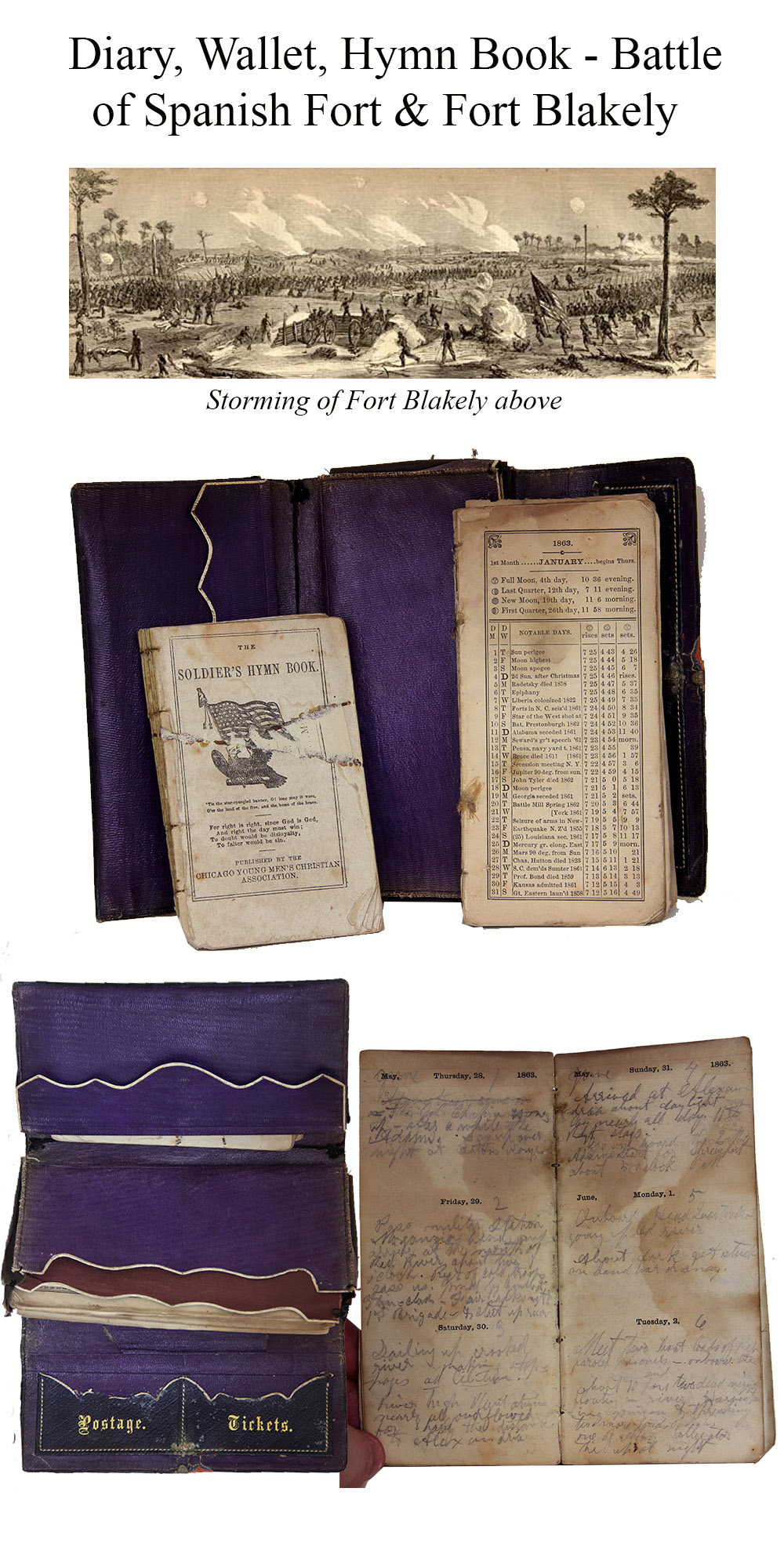
15-02-29 … Spanish Fort Alabama Battle Diary & Related / Diary, Wallet, and Hymn Book …
I purchased these directly from the family descendants but they had no idea who the soldier was, and my research is just scratching the surface. Based on the combat entries we see that the owner was in the 1st Division of the 13th Army Corps. I believe it was written by a soldier in the 46th Illinois or the 47th Indiana but will leave the final research for you. The writer’s early entries relate to Camp Butler, Freeport, and Cairo … all in Illinois. But the 46th Illinois was not present at most of the engagements recorded in the diary. The first casualty he reports is a soldier in the 47th Indiana. He mentions 46th and 47th regiments regularly but not the state affiliations. There is enough data in the entries to track down the regiment but I’ve spent three hours and believe it would take three more. That fun I will leave to you, and it really is good fun to play history detective when you have the time.
Included is a nice folding leather wallet with brass hasp. Found inside the wallet were the hymn book and diary. Both the hymn book and diary lack their covers. The hymn book has separated into two sections. The diary is solid. The soldier uses an 1863 diary for the year of 1865. The entries are from the Mobile campaign, Spanish Fort, and Fort Blakely 1865. The writer renumbered some of the pre printed dates in pencil. The 47th Indiana’s brigade (1st) consisted of the 47th Indiana, 99th Illinois, 21st Iowa, and 29th Wisconsin Infantry regiments. The 46th Illinois’s brigade (2nd) consisted of the 8th, 11th, and 46th Ills.
Following are just a few of the many entries.
March 27th …
“Ordered out on skirmish duty about a mile and make detail for throwing up breastworks. Soon a line of battle is formed in our rear and six times passed us Cannonading commences and our line falls back – we form and march to the left flank. Rains. Ordered to camp about 5 O Clock. One man killed by a shell.” THIS ENTRY IS MARCH 27TH 1865 AND THE KILLED SOLDIER WAS GEORGE REASER OF THE 47TH INDIANA.
April 9th …
“Go off for pipe stems and hunt? bees to Polk.” (I assume they were looking for honey bees.) “Ordered out to storm the rebel works which we do and take 2000 to 3000 prisoners. None injured in 46th. Other regiments lose considerably. Lost gun and everything except knapsack. Pick up Reb accoutrements. Ordered out and made two or three miles.”
(Probably refers to 46th Illinois which was in the same division 13th Corps as the 47th Indiana in 1865.)
April 11th …
” Lay in camp all day. Rebs fire their guns in volleys about dark ordered out in 15 minutes notice. Then marched back past Spanish Fort to steamboat landing. ??? pontoons are sent for us to cross above Blakely … 30 men detailed to load wagons. Myself and balance lay all day. Balance of regt go off for a while about 9 or 10 O clock. camp with 46th corral.” (Not sure what corral means.) There are numerous very good action entries. Also entries showing just how racist he and his comrades were. At one point they occupy a barracks in Louisiana on the way home that had just been vacated by “niggers”. The writer relates that the whole regiment was swearing about the situation. Later he comments that “niggers” go on trial tomorrow.
Dec 22nd …
(YEAR UNCLEAR) ” Murray 6th Wisconsin shot in back of the head. The man who shot him gives himself up…. Bought a knife for $1.” The writer apparently has the regimental number wrong as no one named Murray in the 6th Wisconsin was killed, and the 6th Wisconsin was nowhere near the 13th Army Corps. I’ll let you uncover this mystery. The 8th Wisconsin was in the correct area.
The back of the diary contains notes on who owes money. Names of who owes him ten cents (or perhaps who he owes ten cents) include Lieut. Clerk Co H, Gallaher Co B, John Rand, F. Brue. Unfortunately the writer spells phonetically as none of these names are shown in regiments in his brigade as he spelled them. His best pard in the unit appears to be Errinton … and again this name is phonetic… but likely the key in uncovering the exact regiment and company. Could be Arrington, Harrington, Errington, Arenton, etc. … etc. … The keys are all present, you just need to keep trying the various locks in the data bases until you solve the puzzle. A wonderful lot of historical personal items that were really there
… $975.00
Click Here to E-mail Us!
Call us @ 419-842-1863

15-02-30 … Allen & Wheelock Army Revolver …
Allen and Wheelock made these .44 caliber six-shot revolvers in 1861 and 1862, and this model is the model purchased by the government in 1861. The center-hammer was an improvement on the pre-war side-hammer models, but their ingenious pre-war pivoting triggerguard/loading lever combination was retained. The quantity made is unknown but believed to be a thousand or less. Ours is numbered 204. Smooth metal overall in a brown patina. The front sight is worn down, but present. Overall fair to good condition. The cylinder pin (arbor) is a crude replacement and the arbor release latch is long gone. Other than that the gun is complete. It cocks but cylinder does not index. Wood grips show nice burl grain and are tight to the metal. They are battered and one side has a significant chip on the bottom. The government purchased some 536 Allen and Wheelocks and some were issued to the 2nd and 3rd Michigan cavalry regiments. Average VG examples bring $2000. This old war horse is a solid representative example with good eye appeal. Best part is I can sell it for
… $795.00 – SOLD
Click Here to E-mail Us!
Call us @ 419-842-1863
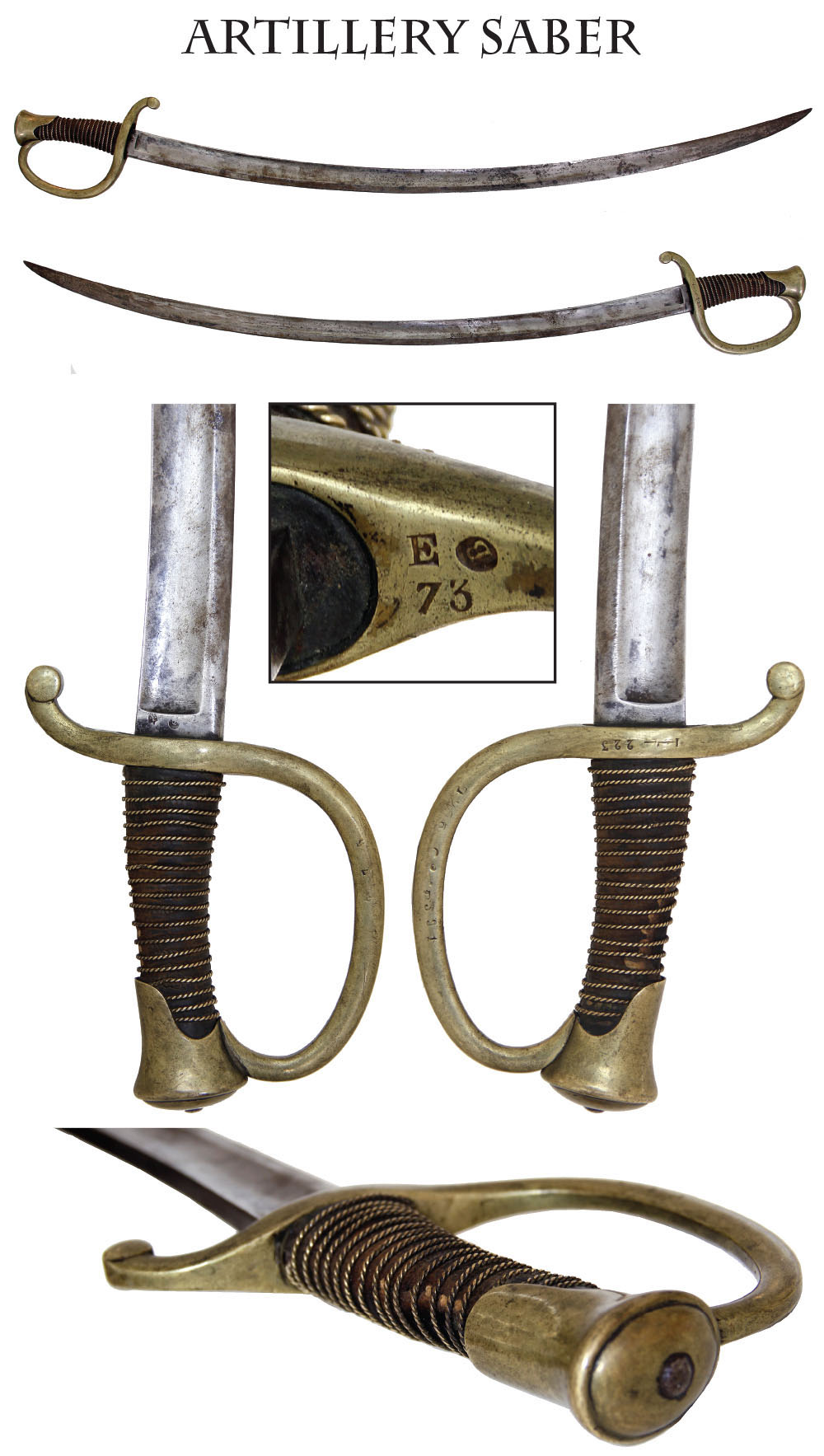
15-02-31 … French Made Import Artillery Enlisted Man’s Saber …
300 French artillery sabers were imported to the US for trial in 1839 and formed the basis for our own 1840 Pattern Light Artillery Sabers. In addition to those 300 some may have made their way over here for militia companies until Ames could meet demand. After the war broke out Napoleon III at some point in 1861 prevented arsenal made arms from being sold to either side, but privately made weapons were exempt and some surplus arms may have been shipped before the embargo. This example is French arsenal made & signed faintly in script on the flat of the spine. It also has inspector and issue marks, such as the “B” in a circle under the guard, and French rack numbers on the knuckle bow. It also has a very American looking rack number E/73 stamped under the guard as well. The blade has a good edge without nicks or chips, showing dull silver gray patina. Overall rates very good. The grip shows wear to the leather and some shrinkage, exposing a little of the wood near the pommel and causing the wire, though secure, to be a tad loose. No scabbard. A good example of the saber we used as a pattern for our own weapon. Most affordable at
… $295.00
Click Here to E-mail Us!
Call us @ 419-842-1863
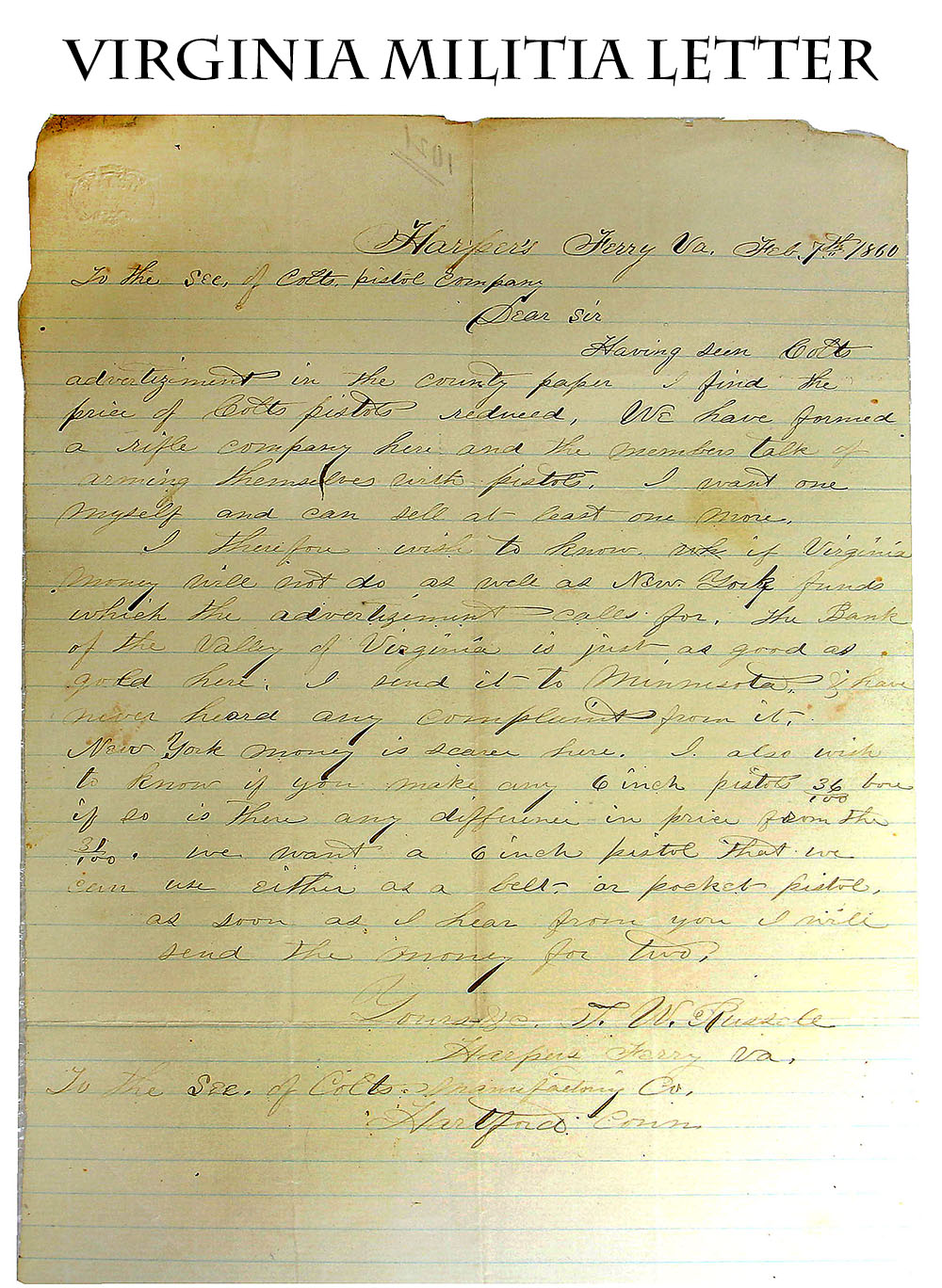
15-02-32 … Rare 1860 Virginia Militia Letter Seeking Colt Revolvers for a Harpers Ferry Company …
Spurred by increasing sectional tensions and especially by John Brown’s raid on Harpers Ferry in 1859, militia companies sprang up all over the south. Here is a very telling letter written from Harpers Ferry itself on February 7, 1860, less than four months after the raid and little more than two months after Brown was hanged. The writer, who seems to sign himself T.W. Russell sends to the Secretary of “Colts Pistol Company” in Hartford saying a rifle company is being formed in Harpers Ferry and asking if they will take Virginia currency in payment for two pistols, with the detail that they are looking for something with a six-inch barrel that can be carried on the belt or in a pocket. There is more than a little regional pride involved in the claim that currency from the Bank of the Valley of Virginia is “as good as gold here,” and that he has used it for purchases even in Minnesota without complaint.
We have not been able to pinpoint the identity of the letter writer to our satisfaction, but the letter evokes the Brown raid, the militia craze, state pride, the looming sectional crisis and perhaps Sam Colt’s willingness to make hay while the sun shone, no matter where the orders were coming from. There’s a little business shrewdness at work on the writer’s part as well: he plans to keep one revolver and sell the other. I will wager most men in his militia company served with the Johnnies the following year. A wonderfully, rural, folksy, countrified letter sent from a militant southerner to the most famous Connecticut Yankee in all the world. Great Colt history. I have owned this letter for many years
… $450.00 – SOLD
Click Here to E-mail Us!
Call us @ 419-842-1863
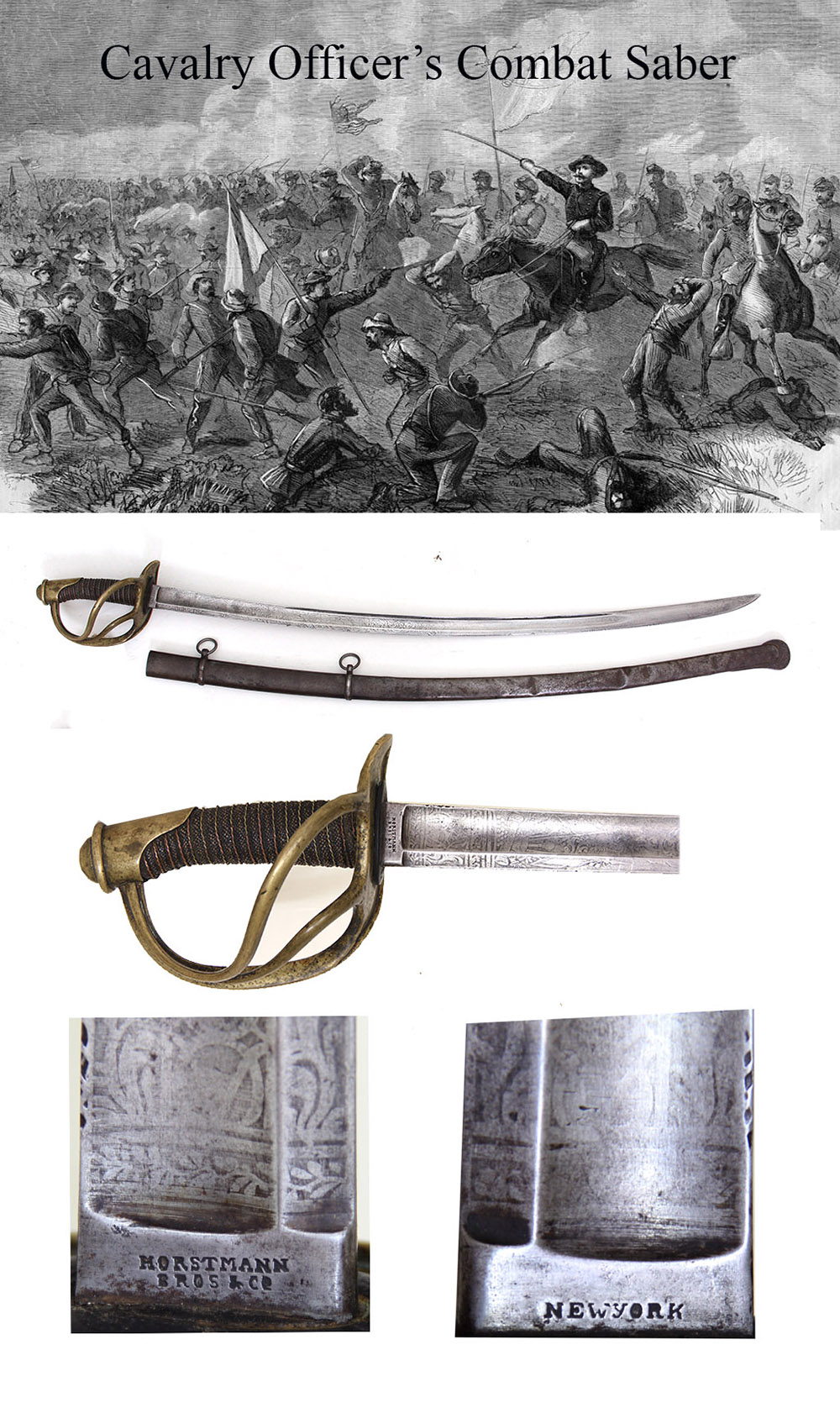
15-02-33 … Very Scarce Horstmann Bros. & Co./ New York Dragoon Officer’s Saber …
Horstmann is a familiar name to collectors from their Philadelphia operation. Here is a scarce example of an 1840 Heavy Cavalry Officer’s Saber with a two-year window of production from their New York branch, which was known as Horstmann Brothers & Company only from 1850 to 1852 when Henry Allien’s name was added to the firm. We often call it an 1840 Pattern Cavalry Officer’s Saber, but with this early a manufacture date it is truly a Dragoon Officer’s Saber, used by officers in the mounted rifle and dragoon regiments before cavalry were introduced in 1855. The sharkskin grip wrap is in excellent shape with full wire. The blade etching is subdued but very visible with the blade showing bright mixed with some silvery gray overall and just some more concentrated gray toward the tip, but no edge damage or pitting. The scabbard lacks a throat and shows some dents and dings along the lower third from actually use and carrying on horseback. Officers purchased their own uniforms and arms, of course, so it does not require any imagination to see a regular army officer purchasing one of these from a New York retailer. This one saw use, as they say, but not abuse. It’s a great prewar cavalry and dragoon officer’s saber from the early Indian Wars on the plains and in the southwest. This is a very scarce saber perfect for a good dragoon or pre-war army display, and undoubtedly saw service in the Civil War as well. A lot of history for very little money
… $895.00 – SOLD
Click Here to E-mail Us!
Call us @ 419-842-1863
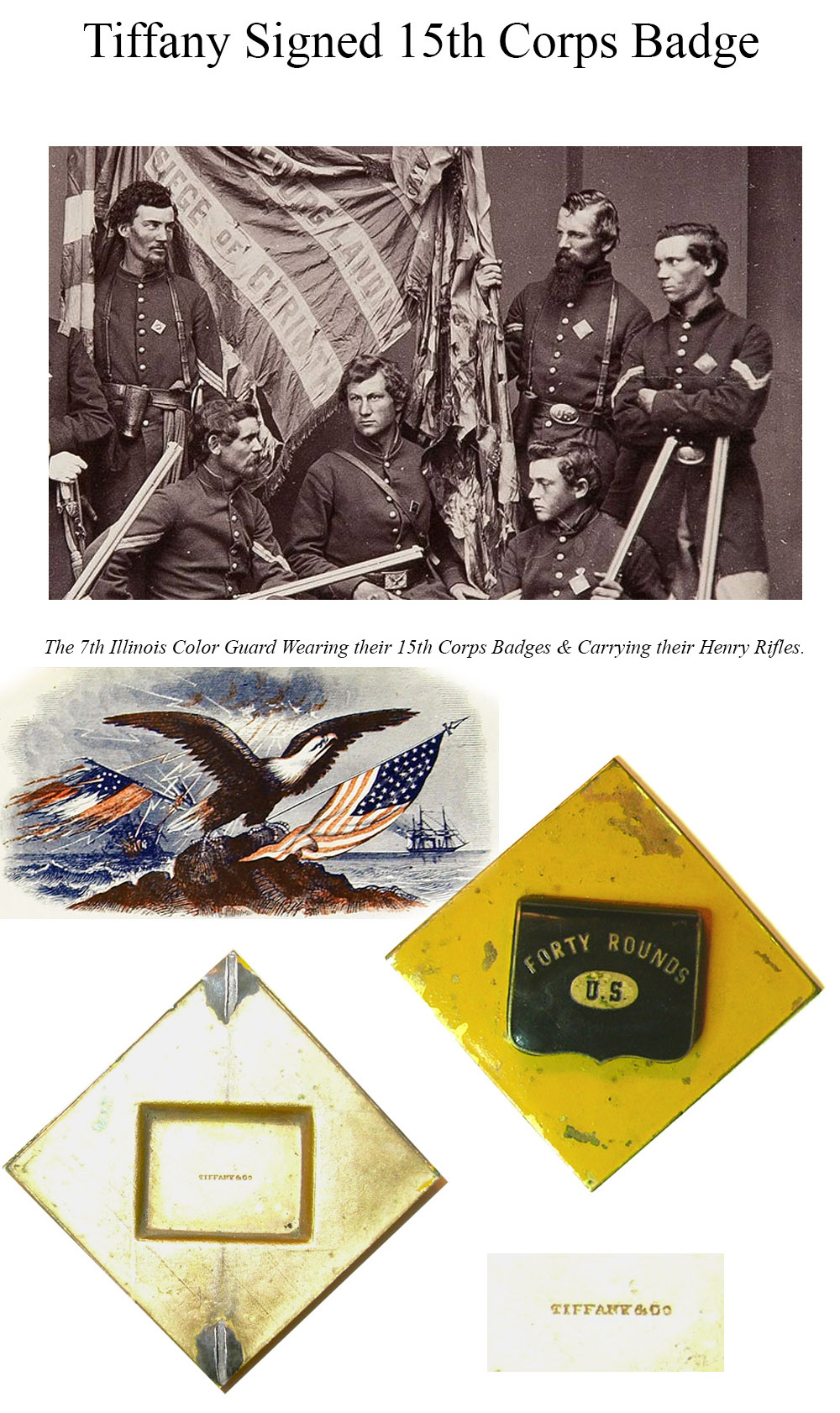
15-02-34 … Dead Real 4th Division 15th Army Corps Badge as Worn by the 7th Illinois Henry Rifle Regiment:
We all know the market is awash in bogus corps badges. When a friend offered me this real one made by Tiffany, I jumped at the chance. Standard size, measuring 2 1/8 inches top to bottom and across, this style of badge shows up occasionally unmarked and more rarely with the Tiffany & Co. name stamped inside the raised area on the reverse that forms the basis for the cartridge box on the face of the badge. General Logan’s initial order authorizing the badge specified it was to be worn “invariably upon the hat or cap” and this influenced Tiffany’s choice of fastening device … Loops mounted at the upper and lower corners. These are frequently found with the loops removed so as not to damage a uniform coat and a pin substituted. This one shows the solder bases for the two loops that are themselves now gone. The story of the design may be apocryphal but it is fun to retell it. The legend says that an eastern soldier recently transferred to the western theater and sporting all the regulation insignia on his cap, asked a veteran westerner in his worn slouch hat where his insignia was. The grizzled Iowan reportedly slapped his cartridge box and told the easterner “this is it”. The face of the badge bears a black enamel cartridge box with the motto “FORTY ROUNDS” and a miniature cartridge box plate with a small “U.S.” The background color is done in thin enamel paint. This one preserves about 80 percent of its original yellow, which in the 15th Corps was used for the Fourth Division, commanded by General Corse while Logan led the corps. It contained the brigades of Rice, Adams and Hurlbut. One of their most well known regiments was the 7th Illinois, whose color guard posed proudly with their Henry Rifles and 4th Division 15th Corps Badges. A very scarce and desirable badge by a famous maker. I paid nearly this much to buy it
… $635.00 – SOLD
Click Here to E-mail Us!
Call us @ 419-842-1863
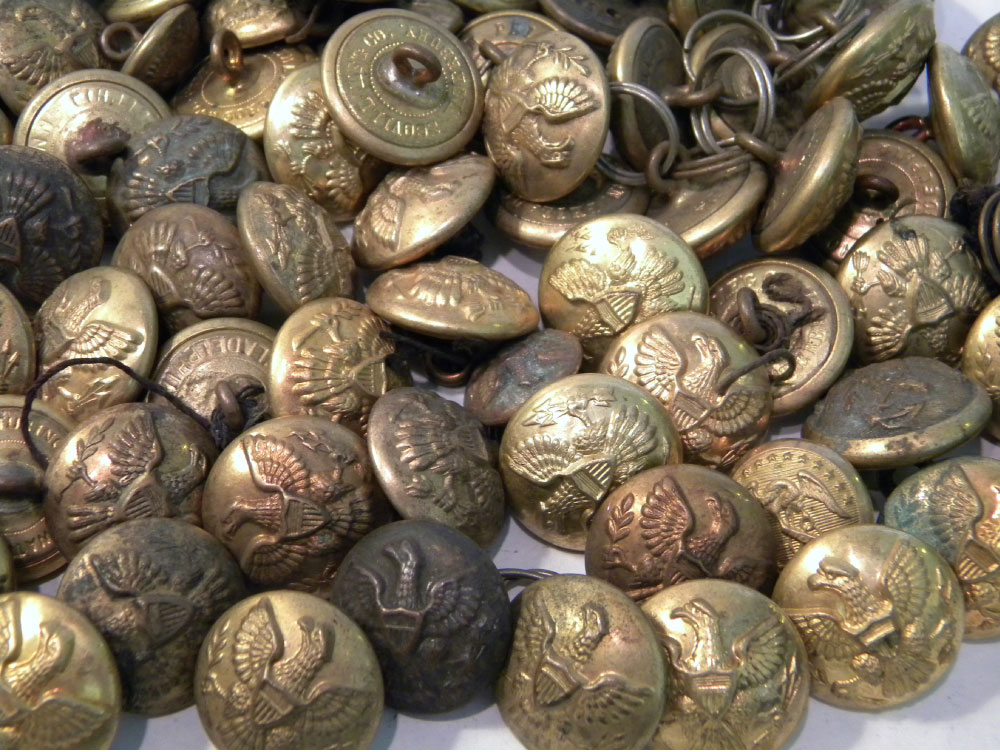
15-02-35 … A lot of TEN Original Indian War Large Size Eagle Coat Buttons.
A few years ago at an eastern Pennsylvania auction I bought a couple large bags full of these early Indian Fighters buttons and then I put them aside and forgot about them. I just stumbled across them again …. So here is a great opportunity…. ten original buttons for $25.00 These can be mailed inexpensively in a padded envelope.
… $25.00 for 10
Click Here to E-mail Us!
Call us @ 419-842-1863
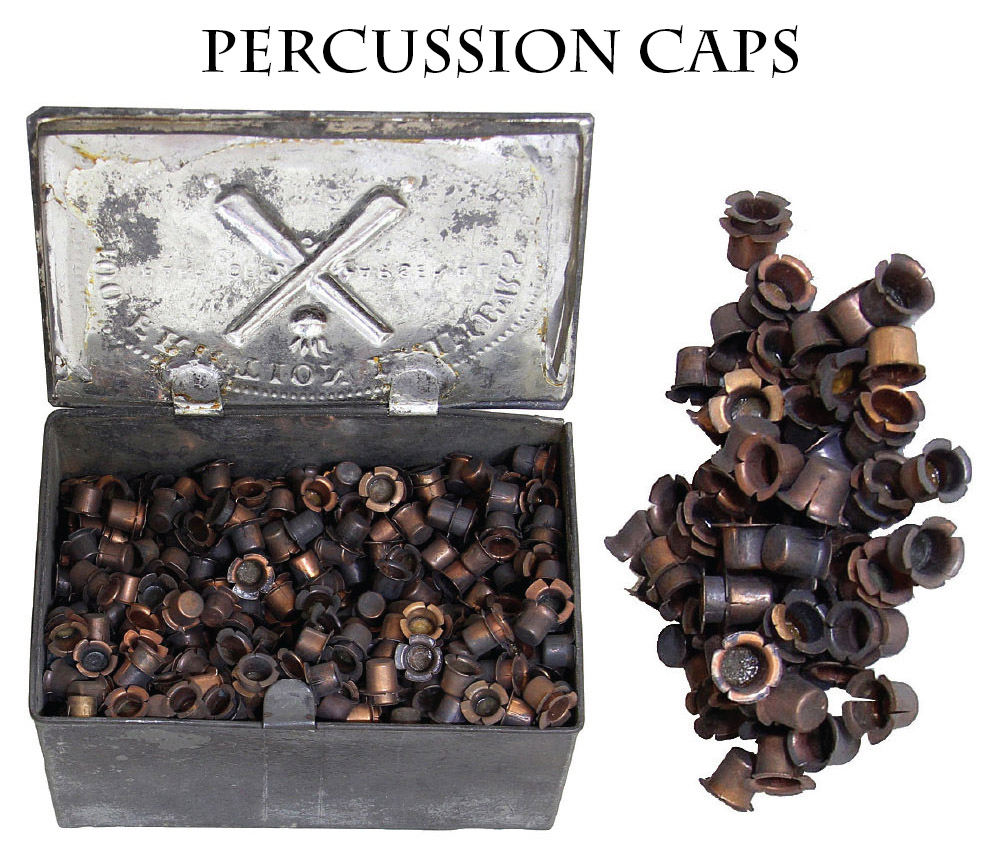
15-02-36 … Friction Primer Tin [Tin not for sale] and Percussion Caps …
I just purchased this neat old relic and am offering the percussion caps inside the tin in this offering. This very scarce tin came just as you see it, filled with percussion caps for muskets. The tin itself is the arsenal tin used to hold artillery friction primers. These are darned hard to find! I can only think of one instance where I found one still in a primer pouch! The tin has a hinged cover with small latch and embossed top reading: 100 FRICTION PRIMERS in an arc over an ordnance insignia, and FRANKFORD ARSENAL on either side. I don t know who put the percussion caps in the tin, it was certainly a handy storage idea, but since they do not belong together, I am splitting up the lot.
In each package of ten cartridges the soldier got 12 caps. While the supply lasts I will sell the percussion caps …
One Dozen … … … $15
Two Dozen … … … $25
Five dozen … … … $50
Click Here to E-mail Us!
Call us @ 419-842-1863
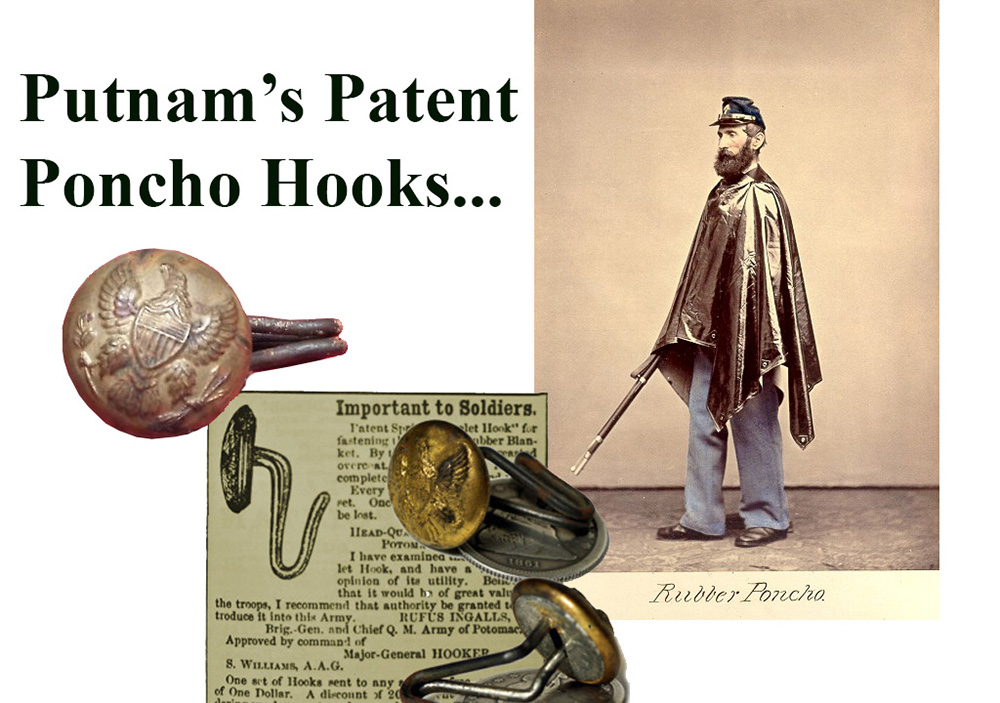
15-02-37 … These buttons were patented in 1862 by Abel Putnam
and made with a long spring shank and were designed to go through the grommets on issue rubber blankets so the sides could be connect ed and the whole thing worn as a poncho in rainy weather.The face is a standard Union Army eagle button. The back is a spring hook fashioned from double spring steel wire. I have very few priced each at
… $45.00
Click Here to E-mail Us!
Call us @ 419-842-1863
Layaways are Welcome
Need to split your order into multiple payments? No problem! A simple 20% earnest money deposit will hold your item for you.-acf
You can then pay it off in easy installments that fit your budget.
Read Terms Here
Items to Sell? Contact Us
I am always interested in buying ANYTHING from the American Civil War… Guns, Swords, Civil War Muskets, Knives, Uniforms, Flags, Medals, Badges, Diaries, Letters, Autographs, Buttons, photographs, tintypes, daguerreotypes, Insignia, Camp Items, Battlefield Relics, canteens, Drums, Etc… Call 419-842-1863 and ask for Dave Taylor.

